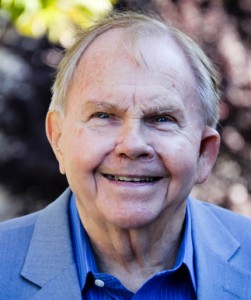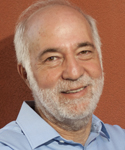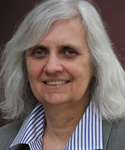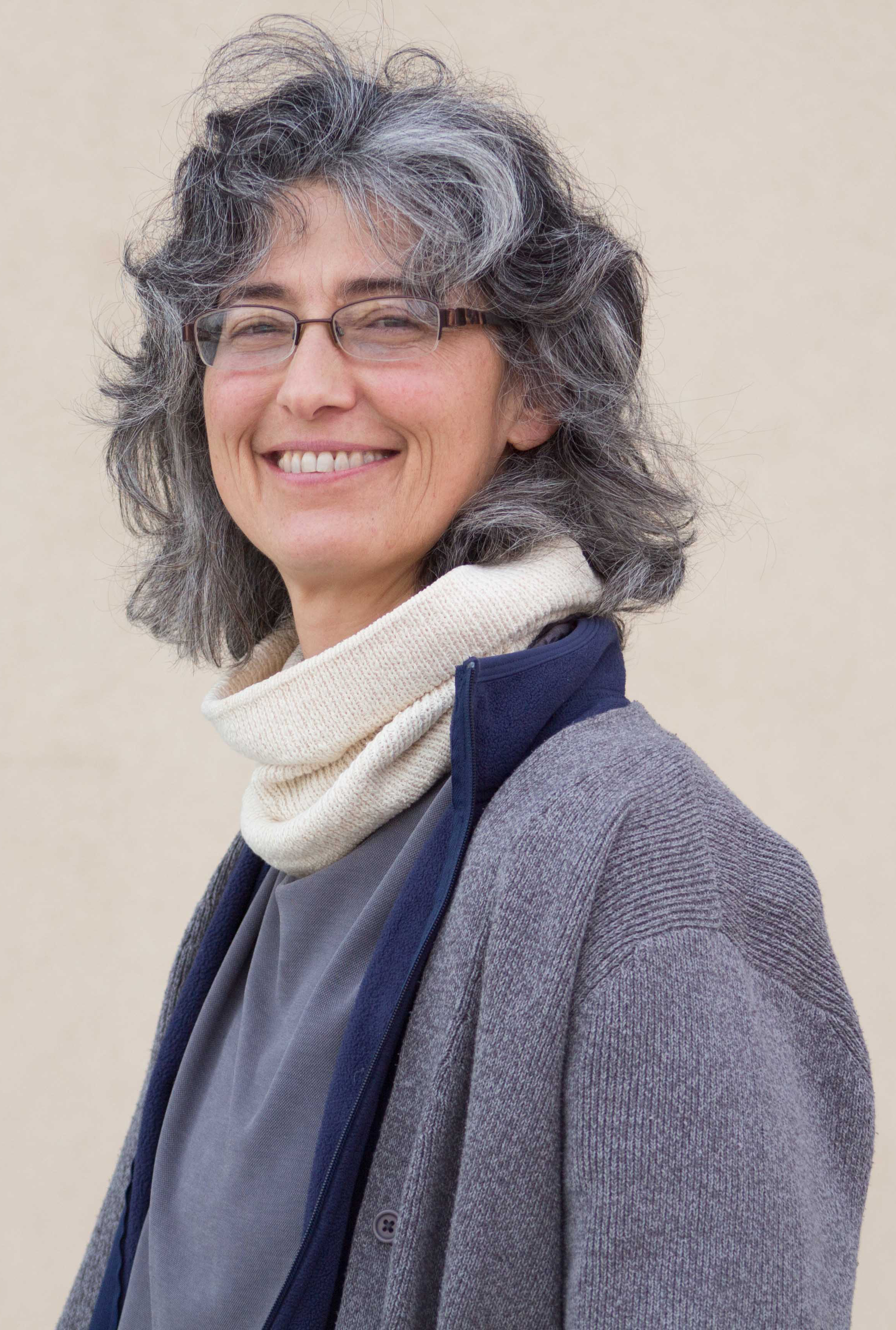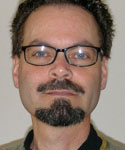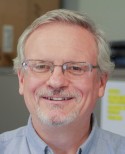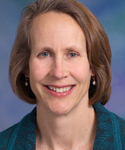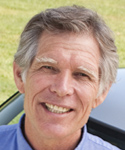
Summary
CCPM 1 and CCPM 2 brought together energy modelers to address a range of energy-related questions in California, with discussions around setting important targets and the policies to achieve these. Following on these two successful one-day workshops held in 2013 and 2015, UC Davis will host a CCPM-3 workshop that will provide important foundational analysis and insights to the California policymakers and stakeholders as they consider possible new targets and policy initiatives in 2018. These may include, but are not limited to:
- A very low GHG target, such as near zero net emissions, by 2050 or earlier
- A very high renewables target post 2030, and
- A ZEV uptake target of 5 million in 2030 and 100% sales target by 2040 or other year.
This workshop will specifically inform the planned Governor’s Global Climate Action Summit in September 2018 and provide a critical scientific foundation for targets considered at that summit.
Like the previous CCPM efforts, this workshop will convene important energy system modelers from around the state to compare specific scenarios relevant to potential or actual California targets and estimate optimal pathways and costs of achieving these targets. It will broaden the discussion out from energy systems to also include a session on agriculture and forestry, and how this sector can contribute to mitigation efforts.
Results from this workshop will be shared with key officials at the Governor’s office, in the legislature, and with the California Air Resources Board and other agencies, and will be fed into the planning for the Governor’s Summit.
Agenda
8:30 a.m. Registration and Coffee
9:00 a.m. Welcome and Introductory Remarks
- Lew Fulton, Co-Director, STEPS Program, UC Davis
- Austin Brown, Executive Director, Policy Institute for Energy, Environment and the Economy, UC Davis
9:10 a.m. Keynote
Aimee Barnes, Senior Advisor, Office of Governor Edmund G. Brown Jr.
9:30 a.m. Session 1: The big picture: Achieving very low CO2 futures
Moderator: Lew Fulton, Co-Director, STEPS Program, UC Davis
- Amber Mahone, Director of Clean Energy, E3
- Noah Deich, Executive Director, Center for Carbon Removal
- Sonia Yeh, Professor, Chalmers University of Technology
Discussion
10:30 a.m. Coffee Break
10:50 a.m. Session 2: Achieving a zero carbon electric sector
Moderator: Amber Mahone, Director of Clean Energy, E3
- Sam Evans, Postdoctoral Fellow, UC Berkeley
- Max Wei, Program Manager, Lawrence Berkeley National Laboratory
- Mark Delucchi, Research Scientist, UC Berkeley
- Daniel Hopper, Senior Manager, Southern California Edison
Discussion
12:10 p.m. Lunch
1:00 p.m. Session 3: Transportation sector targets: 5 million EVs by 2030, 100% ZEV sales in 2040?
Moderator: Marshall Miller, Senior Development Engineer, STEPS
- Chris Busch, Research Director, Energy Innovation
- Gil Tal, Researcher, Plug-In Hybrid & Electric Vehicle Research Center, UC Davis
- Nancy Ryan, Director of Policy and Strategy, E3
Discussion
2:15 p.m. Coffee Break
2:30 p.m. Session 4: Role of agriculture and forestry in achieving very low CO2 futures
Moderator: Noah Deich, Executive Director, Center for Carbon Removal
- Katharine Mach, Senior Research Scientist, Stanford University
- Dick Cameron, Director of Science, Land Conservation Programs, The Nature Conservancy
- Emily McGlynn, PhD Student, UC Davis
Discussion
3:45 p.m. Session 5: Panel and audience discussion - what can we learn from the models/discussion and what don't we know going forward?
Moderator: Anthony Eggert, Transportation Director, ClimateWorks
- Dan Sperling, Director, ITS-Davis and STEPS
- Alice Reynolds, Senior Advisor, Office of Governor Edmund G. Brown Jr.
- Ryan McCarthy, California Air Resources Board
Discussion
5:00 p.m. Closing thoughts
Lew Fulton and Austin Brown
5:15 p.m. Reception (Alumni Center - Moss Patio)
Presentations
BARNES California Scoping Plan
MAHONE Deep Decarbonization in a High Renewables Future
DEICH CA Leadership on Building a New Carbon Economy
YEH The big picture. Achieving very low CO2 futures
EVANS Exploring Economic Impacts of Long-Term California Energy Scenarios
WEI Modeling Climate Change for the 2050 Grid and Supporting High Renewables in 2030
DELUCCHI Cost-benefit analysis of clean energy systems
HOPPER SCE’s Clean Power and Electrification Pathway
BUSCH Policies to Achieve 2030 Targets on ZEVs AND GHGs
MACH Rightsizing expectations for carbon dioxide removal towards ambitious climate goals
CAMERON Ecosystem-based emissions reduction potential in California
Keynote
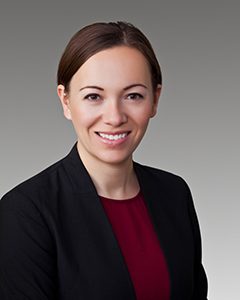
Aimee Barnes
Aimee Barnes is a Partner with Allotrope Partners, focused on investing in low-carbon and clean energy project development in emerging markets. Previously, Aimee was appointed Deputy Secretary for Border and Intergovernmental Relations by Governor Edmund G. Brown Jr. in December 2013. From 2010-2013, she worked as an international climate change policy analyst at the United Arab Emirates Ministry of Foreign Affairs, helping to establish their Directorate of Energy and Climate Change. Aimee advised the Directorate on international climate change policy, including the UN Framework Convention on Climate Change negotiations and the UN Conference on Sustainable Development. Prior to that, Aimee served as a policy advisor to the United Kingdom Department of Energy and Climate Change in their Strategy Directorate from 2009 to 2010. From 2007 to 2009, Aimee was the senior manager for U.S. regulatory affairs at EcoSecurities, and from 2005-2006 she worked as the coordinator of California advocacy and Latino outreach and as a senior land attorney assistant at the Natural Resources Defense Council. In this position she worked on environmental policy advocacy in California, and supported the launch of NRDC’s bespoke Spanish language website, La Onda Verde. Aimee holds a degree in Environmental Studies from Dartmouth College, and a Master of Public Administration degree in Environmental Science and Policy from Columbia University’s School of International and Public Affairs.
Speakers
- 2014
Achieving California’s 80% greenhouse gas reduction target in 2050: Technology, policy and scenario analysis using CA-TIMES energy economic systems model
By Christopher Yang, Sonia Yeh, Saleh Zakerinia, Kalai Ramea and David McCollum
December 4, 2014 - 2015
Supercapacitors in Micro- and Mild Hybrids with Lithium Titanate Oxide Batteries: Vehicle Simulations and Laboratory Tests
By Hengbing Zhao and Andrew Burke
December, 2015Modelling and Analysis of Plug-in Series-Parallel Hybrid Medium-Duty Vehicles
By Hengbing Zhao and Andrew Burke
December, 2015Evaluation of a PV Powered EV Charging Station and its Buffer Battery
By Hengbing Zhao and Andrew Burke
December, 2015The effect of carsharing on vehicle holdings and travel behavior: A propensity score and causal mediation analysis of the San Francisco Bay Area
By Gouri Shankar Mishra, Regina R. Clewlow, Patricia L. Mokhtarian, Keith F. Widaman
November 14, 2015A Global High Shift Cycling Scenario: The Potential for Dramatically Increasing Bicycle and E-bike Use in Cities Around the World, with Estimated Energy, CO2, and Cost Impacts
By Jacob Mason, Lew Fulton, and Zane McDonald
November 12, 2015Generation Y: Lifestyles and Mobility Choices of Millennials in California, and the Motivations behind Them
By Aria Berliner, Giovanni Circella, Eric Gudz and Lewis Fulton
November, 2015Lifestyles, Residential Location, Adoption of Emerging Technologies of Social Networks, Car Ownership and Mobility Choices of Millenials
By Giovanni Circella, Lewis Fulton, Aria Berliner, Farzad Alemi, Patricia L. Mokhtarian and Susan L. Handy
November, 2015WAR AND THE OIL PRICE CYCLE
By Amy Myers Jaffe and Jareer Elass
Fall/Winter, 2015The design and economics of low carbon fuel standards
By Gabriel E. Lade and C.-Y. Cynthia Lin Lawell
October 27, 2015Testing substitution between private and public storage in the U.S. oil market: A study on the U.S. Strategic Petroleum Reserve
By Daniel Paul Scheitrum, Colin A. Carter and Amy Myers Jaffe
October 25, 2015Three routes forward for biofuels: Incremental, leapfrog, and transitional
By Geoff M. Morrison, Julie Witcover, Nathan C. Parker, Lew Fulton
October 24, 2015Science and the stock market: Investors’ recognition of unburnable carbon
By Paul A. Griffin, Amy Myers Jaffe, David H. Lont,, Rosa Dominguez-Faus
October 24, 2015Regional Turmoil and Realignment: Middle East Conflicts and the New Geopolitics of Oil
By Amy Myers Jaffe and Jareer Elass
September 21, 2015Comparison of low-carbon pathways for California
By Geoffrey M. Morrison, Sonia YehAnthony R. Eggert, Christopher Yang, James H. Nelson, Jeffery B. Greenblatt, Raphael Isaac, Mark Z. Jacobson, Josiah Johnston, Daniel M. Kammen, Ana Mileva, Jack Moore, David Roland-Holst, Max Wei, John P. Weyant, James H. Williams, Ray Williams, Christina B. Zapata
August, 2015A review of learning rates for electricity supply technologies
By Edward S. Rubin, Inês M.L. Azevedo, Paulina Jaramillo, Sonia Yeh
July 15, 2015The need for biofuels as part of a low carbon energy future
By Lewis M. Fulton, Lee R. Lynd, Alexander Körner, Nathanael Greene and Luke R. Tonachel
June 22, 2015A network-based dispatch model for evaluating the spatial and temporal effects of plug-in electric vehicle charging on GHG emissions
By Julia Sohnen, Yueyue Fan, Joan Ogden, Christopher Yang
May 26, 2015Status Review of California’s Low Carbon Fuel Standard
By Sonia Yeh, Julie Witcover and James Bushnell
April, 2015Analytic Tool to Support the Implementation of Electric Vehicle Programs
By Andrew Burke, Gustavo O. Collantes, Marshall Miller, Hengbing Zhao
April, 2015Applications of Supercapacitors in Electric and Hybrid Vehicles
By Andrew Burke and Hengbing Zhao
April, 2015Do biofuel policies seek to cut emissions by cutting food?
By T. Searchinger, R. Edwards2, D. Mulligan, R. Heimlich and R. Plevin
March 27, 2015The CARBON INTENSITY of NGV C8 TRUCKS
By Rosa Dominguez-Faus
March 2, 2015Past and Future Land Use Impacts of Canadian Oil Sands and Greenhouse Gas Emissions
By Sonia Yeh, Anqi Zhao, Sean D. Hogan, Adam R. Brandt, Jacob G. Englander, David W. Beilman andMichael Q. Wang
January, 2015Large urban freight traffic generators: Opportunities for city logistics initiatives
By Miguel Jaller, Xiaokun (Cara) Wang
2015Achieving California’s Greenhouse Gas Goals: A Focus on Transportation
By Gustavo O. Collantes, Anthony R. Eggert, Rod Brown, Susan L. Handy, Jeff Kessler, Chuck Shulock, Julie Witcover and Sonia Yeh
2015Oil Sands Energy Intensity Assessment Using Facility-Level Data
By Jacob G. Englander, Adam R. Brandt, Amgad Elgowainy, Hao Cai, Jeongwoo Han, Sonia Yeh, and Michael Q. Wang
2015Carbon Accounting and Economic Model Uncertainty of Emissions from Biofuels-Induced Land Use Change
By Richard J. Plevin, Jayson Beckman, Alla A. Golub, Julie Witcover and Michael O’Hare
2015Modal Shift of Passenger Transport in a TIMES Model: Application to Ireland and California
By Hannah E. Daly, Kalai Ramea, Alessandro Chiodi, Sonia Yeh, Maurizio Gargiulo and Brian Ó Gallachóir
2015 - 2016
Making the Transition to Light-duty Electric-drive Vehicles in the U.S.: Costs in Perspective to 2035
By Joan Ogden, Lew Fulton, Dan Sperling
December 12, 2016Detailed assessment of global transport-energy models’ structures and projections
By Sonia Yeh, Gouri Shankar Mishra, Lew Fulton, Page Kyle, David L. McCollum, Joshua Miller, Pierpaolo Cazzola, Jacob Teter
November 2, 2016Energy Intensity and Greenhouse Gas Emissions from Tight Oil Production in the Bakken Formation
By Adam R. Brandt, Tim Yeskoo, Michael S. McNally, Kourosh Vafi, Sonia Yeh, Hao Cai and Michael Q. Wang
October 20 2016Renewable Natural Gas as a Solution to Climate Goals: Response to California’s Low Carbon Fuel Standard
By Daniel Scheitrum
October 2016North American natural gas and energy markets in transition: insights from global models
By Sonia Yeh, Yiyong Cai, Daniel Huppman, Paul Bernstein, Sugandha Tuladhar, Hillard G. Huntington
September 1, 2016Energy Investing and Climate Change: Recommendations for the Next U.S. President
By Jagdeep Singh Bachher, Amy Myers Jaffe
September 2016Tracking U.S. biofuel innovation through patents
By Jeff Kessler, Daniel Sperling
August 25 2016Modeling of Greenhouse Gas Reductions Options and Policies for California to 2050: Analysis and Model Development Using the CA-TIMES Model
By Christopher Yang, Sonia Yeh, Kalai Ramea, Saleh Zakerinia, Alan Jenn, David S. Bunch
July, 2016The Feasibility of Renewable Natural Gas as a Large-Scale, Low Carbon Substitute
By Amy Myers Jaffe, Rosa Dominguez-Faus, Nathan C. Parker, Daniel Scheitrum, Justin Wilcock, Marshall Miller
June, 2016Recent Trends in Water Use and Production for California Oil Production
By Kate Tiedeman, Sonia Yeh, Bridget R. Scanlon, Jacob Teter, and Gouri Shankar Mishra
May 13, 2016Status Review of California’s Low Carbon Fuel Standard, 2011–2015
By Sonia Yeh, Julie Witcover
May, 2016Moving beyond alternative fuel hype to decarbonize transportation
By Noel Melton, Jonn Axsen & Daniel Sperling
Feb 22, 2016Chapter 5 Update: Why History Won’t Repeat Itself for OPEC This Time Around
By Amy Myers Jaffe and Edward L. Morse
Feb 11, 2016Forest Biomass, carbon neutrality and climate change mitigation
By Göran Berndes, Bob Abt, Antti Asikainen, Annette Cowie, Virginia Dale, Gustaf Egnell, Marcus Lindner, Luisa Marelli, David Paré, Kim Pingoud and Sonia Yeh
2016CAN WE ACHIEVE 100 MILLION PLUG-IN CARS BY 2030?
By Lew Fulton, Gil Tal and Tom Turrentine
2016Changing Oil Market Fundamentals and the Implications for OPEC Production Strategy
By Daniel Scheitrum, Amy Myers Jaffe and Lew Fulton
2016STEPS White Paper: Exploring the Role of Natural Gas in U.S. Trucking (Revised Version)
By Amy Myers Jaffe, Rosa Dominguez-Faus, Allen Lee, Kenneth Medlock, Nathan Parker, Daniel Scheitrum, Andrew Burke, Hengbing Zhao and Yueyue Fan
2016 - 2017
An Overview of Costs for Vehicle Components, Fuels, Greenhouse Gas Emissions and Total Cost of Ownership – Update 2017
By Michael Fries et al.
December, 2017Optimization of Hybrid Electric Drive System Components in Long-Haul Vehicles for Evaluation of Customer Requirements
By Michael Fries, S Wolff, L Horlbeck, M Kerler, M Lienkamp, A. Burke and L. Fulton
December, 2017Natural Gas as a Bridge to Hydrogen Transportation Fuel, Insights From The Literature
By Joan Ogden, Amy Jaffe, Daniel Scheitrum, Zane McDonald, and Marshall Miller
December 1, 2017Estimating Criteria Pollutant Emissions Using the California 2 Regional Multisector Air Quality Emissions (CA-REMARQUE) 3 Model v1.0
By Christina B. Zapata , Chris Yang , Sonia Yeh , Joan Ogden , and Michael J. Kleeman
November, 2017Low Carbon Energy Generates Public Health Savings in 2 California
By Christina B. Zapata , Chris Yang , Sonia Yeh, Joan Ogden , and Michael J. Kleeman
November, 2017Truck Choice Modeling: Understanding California’s Transition to Zero-Emission Vehicle Trucks Taking into Account Truck Technologies, Costs, and Fleet Decision Behavior
By Lew Fulton, Marshall Miller, and Qian Wang
November, 2017Geospatial, Temporal and Economic Analysis of Alternative Fuel Infrastructure: The Case of Freight and U.S. Natural Gas Markets
by Yueyue Fan, Allen Lee, Nathan Parker, Daniel Scheitrum, Amy Myers Jaffe, Rosa Dominguez-Faus, and Kenneth Medlock III
November, 2017
Disruptive Transportation: The Adoption, Utilization, and Impacts of Ride-Hailing in the United States
By Regina R. Clewlow and Gouri Shankar Mishra
October 2017Fuel Economy Analysis of Medium/Heavy-duty Trucks – 2015-2050
By Andrew Burke and Hengbing Zhao
October 9 – 11, 2017
Cycle Life of Lithium-ion Batteries in Combination with Supercapacitors: The effect of load-leveling (ARTICLE)
Cycle life testing of 18650 Li-ion cells with pulsed charge/discharge profiles (POSTER)
By Andy Burke and Jingyuan Zhao
October 9-11, 2017Aspects of Thermal Management of Lithium Batteries in PHEVs Using Supercapacitors
By Andy Burke and Hengbing Zhao
October 9-11, 2017Considerations in the use of supercapacitors in combination with batteries in vehicle applications (POSTER)
By Andy Burke and Hengbing Zhao
October 9-11, 2017Renewable Natural Gas Provides Viable Commercial Pathway for Sustainable Freight (POLICY BRIEF)
By Amy Jaffe, Rosa Dominguez-Faus and Austin Brown
September 2017California low carbon fuel policies and natural gas fueling infrastructure: Synergies and challenges to expanding the use of RNG in transportation.
By Daniel Scheitrum, Amy Myers Jaffe, Rosa Dominguez-Faus, and Nathan Parker
August, 2017
Propulsion Systems for 21st Century Rail
By Raphael Isaac and Lew Fulton
July, 2017What Can Transport Deliver? Contrasting Scenario Pathways with New Technology Penetration
By Shigeki Kobayashi, Lewis Fulton, and Maria Figueroa.
June, 2017Can We Reach 100 Million Electric Vehicles World Wide by 2030?
By Lew Fulton, Alan Jenn and Gil Tal
May 17, 2017
Three Revolutions in Urban Transportation
By Lew Fulton – UC Davis, Jacob Mason – ITDP, Dominique Meroux – UC Davis
May 3, 2017The Potential to Build Current Natural Gas Infrastructure to Accommodate the Future Conversion to Near-Zero Transportation Technology
By Amy Myers Jaffe, Rosa Dominguez-Faus, Joan Ogden, Nathan C. Parker, Daniel Scheitrum, Zane McDonald, Yueyue Fan, Tom Durbin, George Karavalakis, Justin Wilcock, Marshall Miller, Christopher Yang
March 2017What Affects Millennials’ Mobility? PART II: The Impact of Residential Location, Individual Preferences and Lifestyles on Young Adults’ Travel Behavior in California
By Giovanni Circella, Farzad Alemi, Kate Tiedeman, Rosaria Berliner, Youngsung Lee, Lew Fulton, Patricia Mokhtarian and Susan Handy
March 2017 - 5.2017 Spring Symposium
Workshop info: TBA
- 2018
A Comparison of Zero-Emission Highway Trucking Technologies
by Hengbing Hao, Qian Wang, Lewis Fulton, Miguel Jaller and Andrew Burke
October 2018
Status Review of California’s Low Carbon Fuel Standard, 2011–2018 Q1September 2018 Issue
by Julie Witcover
September 2018
CCPM3 Workshop Report and Recommendations to the State of California
by Lew Fulton, Austin Brown and Rosa Dominguez-Faus
August 2018
Steering the Electric Vehicle Transition to Sustainability
By Tom Turrentine, Scott Hardman, and Dahlia Garas
July 2018
Three Revolutions in Urban Passenger Travel
By Lewis M. Fulton and Junia Compostella
March 2018The Prospects for Hydrogen in the Future Energy System
By Joan Ogden
March 2018What Drives Your Drivers? An In-Depth Look At Lyft And Uber Drivers
By Aria Berliner and Gil Tal
February 2018Biofuel Tracker: Capacity for Low Carbon Fuel Policies- Assessment through 2018
By Julie Witcover and Robert B Williams
January 2018 - 3 Revolutions3 Revolutions
- Zero-emission long-haul trucking technologies are being developed that can play a critical role in achieving California’s climate change goals and virtually eliminate air pollution from these vehicles
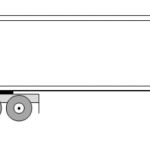
- Kendall, Alissa

- Alissa Kendall
- Associate Professor, Civil & Environmental
Engineering - Graduate Adviser, Transportation Technology and
Policy Graduate Group - Research Interests:
Life cycle modeling applied to transportation systeM.S.; Energy systeM.S.; Construction materials, and buildings, with the goal of developing sustainable systeM.S..
- Contact Info
- 3167 Ghausi Hall
- (530) 752-5722
- amkendall@ucdavis.edu
- Alumna Julia Sohnen’s Career Charges Forward with BMW
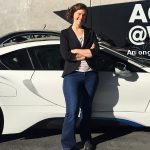
As an advanced technology engineer for the BMW Group Technology Office, Julia Sohnen, M.S., Transportation Technology and Policy (TTP), works to improve sustainable mobility and innovation with one of the largest automobile manufacturers in the world — all within the heart of California’s Silicon Valley.
Sohnen conducts customer research for the BMW i ChargeForward program. This program partners with California’s Pacific Gas and Electric Company (PG&E) to study how electric vehicles can operate as a flexible load on the electricity grid through the forward-looking concept known as smart charging. The idea is to manage at-home electric vehicle charging to help the utility manage peak load, stabilize the grid, and provide cleaner source energy.
When PG&E is experiencing peak load conditions, participating BMW i3 electric vehicle owners who volunteered for the ChargeForward program may be asked to delay charging for up to an hour. Owners can choose to opt out of any single delayed charging request. All of this research is being conducted locally in the San Francisco Bay area.
“Now that the program has started, my responsibility is managing all the customer research and establishing research goals,” Sohnen said. “We want to explore how to better match charging of the electric vehicles to dynamic energy supply sources.” While Sohnen conducts fresh research in automotive innovation, she likes to stay connected to her Aggie network, tracing her beginnings with BMW back to ITS-Davis and its multidisciplinary TTP program.

Sohnen, like many recent graduates, did some soul-searching before arriving at her position with BMW. With a background in mechanical and aerospace engineering, she started her career working for Boeing Satellite Systems in Los Angeles. Realizing that she wanted to shift her focus to sustainability, Sohnen left Boeing to return to school.
“I wanted to apply my control systems background to energy systems. A former professor at Cornell suggested ITS-Davis, specifically for the STEPS (Sustainable Transportation Energy Pathways) program. The transportation-energy pathways and the infrastructure component really aligned well with where I wanted to go next. It was a perfect fit.”
At ITS-Davis, there is no average student, typical path, or standard curriculum. Students develop their own multidisciplinary program. The flexibility of the TTP program combined with Sohnen’s clear goals and aspirations led her to her current profession. It turns out Sohnen’s thesis on carbon emissions associated with charging electric vehicles is a timely topic related to her current work.
“Through that thesis and the connections I made in the STEPS program, I was able find this position,” Sohnen explained.
Sohnen took advantage of networking opportunities with BMW and other automobile companies, made available to her through the ITS-Davis STEPS program. She networked with several BMW engineers at the STEPS symposia and reached out to her connections when beginning her job hunt. She is now approaching her third year with BMW, working on second-life battery research and technology scouting, in addition to the BMW i ChargeForward program.
“Students should realize the advantage of the program and how Davis is a strong network for state agencies, other universities, and industries,” Sohnen reflected. “There are a lot of talented people that come out of ITS-Davis and stay in this electric vehicle space. These are the people you will be constantly running into for the rest of your career.”
- Burke, Andrew F.

- Andrew F. Burke
- Research Engineer, ITS-Davis
- Research Interests:
Electric and hybrid vehicle design, analysis, and testing; applications of batteries and ultracapacitors for electric
- Contact Info
- 1715 Tilia Street (West Village)
- (530) 752-9812
- afburke@ucdavis.edu
- Assessment of Critical Barriers and Opportunities to Commercialize Medium and Heavy Duty Truck Technologies in CA
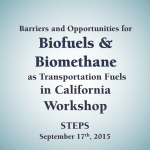
Assessment of Critical Barriers and Opportunities to Commercialize Medium and Heavy Duty Truck Technologies in CA
September 17, 2015 at UC Davis
Agenda & Attendees
Pre-workshop/Background Materials
- Workshop Questions
- Potential Low-Carbon Fuel Supply to Pacific Coast, US – Jan. 2015 (ICCT: Malins, Lutsey, et al)
- Carbon Intensity Values for various fuels, new CA-GREET 2.0 (ARB)
- Final illustrative scenario, part of LCFS rulemaking package (ARB)
- Status Review of CA LCFS – April 2015 (Yeh, Witcover, Bushnell) / Download pdf
- Alternative and Renewable Fuel and Vehicle Technology Program Project Funding – Compendium Narrative – Apr. 2015 (CA Energy Commission)
Presentations
- Session 1 – Russell Teall, Biodico
- Session 1 – Reinhard Seiser, UC San Diego
- Session 1 – Steve Kaffka, UC Davis
- Session 1 – Anil Prabhu, ARB
- Session 2 – Ethan Elkind, UC Berkeley & UCLA Law School
- Session 2 – Evan Williams, Cambrian Energy
- Session 2 – Andy Foster, Aemetis
- Session 3a – Michele Wong, CleanWorld
- Session 3b – Lyle Schlyer, Pixley Biogas
- Session 3c – Tim Olson, CA Energy Commission
- Session 3e – Dan Goodwin, Oberon
- Session 3f – Mike Lewis, Pearson Fuels
- Assessment of Critical Barriers and Opportunities to Commercialize Medium and Heavy Duty Truck Technologies in CA
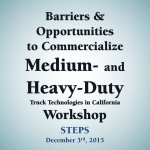
September 17, 2015 at UC Davis
Agenda & Attendees
Pre-workshop/Background Materials
- Workshop Questions
- Potential Low-Carbon Fuel Supply to Pacific Coast, US – Jan. 2015 (ICCT: Malins, Lutsey, et al)
- Carbon Intensity Values for various fuels, new CA-GREET 2.0 (ARB)
- Final illustrative scenario, part of LCFS rulemaking package (ARB)
- Status Review of CA LCFS – April 2015 (Yeh, Witcover, Bushnell) / Download pdf
- Alternative and Renewable Fuel and Vehicle Technology Program Project Funding – Compendium Narrative – Apr. 2015 (CA Energy Commission)
Presentations
- Session 1 – Russell Teall, Biodico
- Session 1 – Reinhard Seiser, UC San Diego
- Session 1 – Steve Kaffka, UC Davis
- Session 1 – Anil Prabhu, ARB
- Session 2 – Ethan Elkind, UC Berkeley & UCLA Law School
- Session 2 – Evan Williams, Cambrian Energy
- Session 2 – Andy Foster, Aemetis
- Session 3a – Michele Wong, CleanWorld
- Session 3b – Lyle Schlyer, Pixley Biogas
- Session 3c – Tim Olson, CA Energy Commission
- Session 3e – Dan Goodwin, Oberon
- Session 3f – Mike Lewis, Pearson Fuels
- Availability of biomass within California
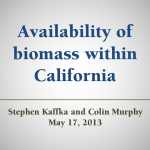
Bioenergy can contribute to California’s climate-change and economic goals by producing low-carbon electricity and fuels. Our state has the high-tech business capacity to be a leader in this field, as well as abundant potential resources, from our agricultural and forest lands as well as municipal solid waste. These resources have not yet been fully utilized. The UC Davis Policy Institute for Energy, Environment and the Economy in partnership with the California Biomass Collaborative presented a series of forums during Spring and Summer 2013, to explore this issue. At the heart of this discussion is the question: How can scientists and policy makers sustainably unlock the vast potential of California’s farms, forests and waste streams?
Click here to view the presentation.
The first webinar took place on May 17th 2013, and addressed basic questions about the availability of biomass within California, including:
- What bioenergy products are currently operating in California?
- How much biomass is available in the state and where will it be produced?
- What is California’s current plan for bioenergy?
Speakers:- Stephen Kaffka, Extension Agronomist – Department of Plant Sciences, Director – California Biomass Collaborative
- Colin Murphy, PhD Candidate, Institute of Transportation Studies
- Behdad Kiani


- Behdad Kiani
- Assistant Project Scientist
- Research Interests:
Integrated energy systems modeling, techno-economic optimization, grid integration, renewable energy, water-energy nexus, carbon tax policy, , storage systems, electric vehicles and smart grids
- Contact Info
- 1715 Tilia Street (West Village)
- bkiani@ucdavis.edu
- Big data makes its presence felt across the energy industry: Q&A with Amy Myers Jaffe

Click here for the Q&A PDF.
- Biofuel Tracker Report
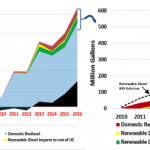
Biofuel Tracker: Capacity for Low Carbon Fuel Policies – Assessment through 2018 report follows the discontinued annual Advanced Biofuel Market Report produced by E2. This new report updates information on transportation biofuel production capacity since E2’s final publication in 2015.
Like its predecessors, the criteria for this report are biofuels assessed by the California Air Resources Board with a carbon intensity rating at least 50% below that of petroleum-based reference fuels, and producers in the United States and Canada. Virgin oil biodiesel falls within the study criteria and is included in the report due to a carbon intensity rating revision due to changed modeling; it was out of scope in the earlier modeling and excluded from the E2 reports. The focus is liquid biofuels, including dimethyl ether (DME), a liquid at moderate pressure, and excludes biogas.
The report provides information on market plans for near-term production capacity through 2018. It is neither a prediction nor a forecast of either capacity or actual production levels. Rather, it is one indication of potential North American production of fuel volume that meets the California carbon intensity rating cut-off in the next couple of years, given favorable market conditions and the current policy environment. For commercially emerging technologies and fuels, production capacity ranges are assessed based on company and media reports, and are filtered through a subjective evaluation of the likelihood of announced capacity coming online in the 2018 timeframe. The low end of the production capacity range reflects capacity in which we have higher confidence: existing capacity plus companies that have shown signs of plans to move forward on the ground. The high end of the production capacity range includes capacity from companies that is assessed as less likely: from companies that still face some significant hurdle (e.g., financing) to meet targets or have not pinned down target dates due to unfavorable market conditions. Well-established technologies and fuels like biodiesel are treated separately. In the case of biodiesel, production is determined by policy more than it is constrained by capacity. Therefore, the focus of this report is on describing the policies and other industry trends. The report includes information on private and public financing levels for biofuels, drawing, like the E2 series, on Clean Tech Group’s industry financial data plus government data, through 2015.
Read full report here
- Biofuels
The biofuels track examines questions surrounding the feasibility, business case for, and sustainability of future biofuels. Much of the focus of this track is on non-corn based biofuels such as renewable diesel, cellulosic ethanol, and drop-in petroleum replacements, among others. Our research answers important policy questions for the state of California, the United States, and the world using a variety of economic, modelling/simulation, and life cycle methods. Broadly, the track examines how and to what extent biofuels can contribute to a sustainable energy future.
Research Leaders: Lew Fulton, Nathan Parker, Stephen R. Kaffka, Julie Witcover
Three Routes Forward for Biofuels: Incremental, Transitional, and Leapfrog
- White Paper (42 Pages)
- Four-page Summary
- Webinar May 16, 2014
- News Release July 24, 2014
- Blog July 24, 2014
- CCPM3
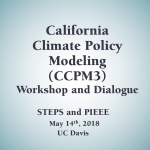

CCPM 1 and CCPM 2 brought together energy modelers to address a range of energy-related questions in California, with discussions around setting important targets and the policies to achieve these. Following on these two successful one-day workshops held in 2013 and 2015, UC Davis will host a CCPM-3 workshop that will provide important foundational analysis and insights to the California policymakers and stakeholders as they consider possible new targets and policy initiatives in 2018. These may include, but are not limited to:
- A very low GHG target, such as near zero net emissions, by 2050 or earlier
- A very high renewables target post 2030, and
- A ZEV uptake target of 5 million in 2030 and 100% sales target by 2040 or other year.
This workshop will specifically inform the planned Governor’s Global Climate Action Summit in September 2018 and provide a critical scientific foundation for targets considered at that summit.
Like the previous CCPM efforts, this workshop will convene important energy system modelers from around the state to compare specific scenarios relevant to potential or actual California targets and estimate optimal pathways and costs of achieving these targets. It will broaden the discussion out from energy systems to also include a session on agriculture and forestry, and how this sector can contribute to mitigation efforts.
Results from this workshop will be shared with key officials at the Governor’s office, in the legislature, and with the California Air Resources Board and other agencies, and will be fed into the planning for the Governor’s Summit.
8:30 a.m. Registration and Coffee
9:00 a.m. Welcome and Introductory Remarks
- Lew Fulton, Co-Director, STEPS Program, UC Davis
- Austin Brown, Executive Director, Policy Institute for Energy, Environment and the Economy, UC Davis
9:10 a.m. Keynote
Aimee Barnes, Senior Advisor, Office of Governor Edmund G. Brown Jr.
9:30 a.m. Session 1: The big picture: Achieving very low CO2 futures
- Moderator: Lew Fulton, Co-Director, STEPS Program, UC Davis
-
- Amber Mahone, Director of Clean Energy, E3
- Noah Deich, Executive Director, Center for Carbon Removal
- Sonia Yeh, Professor, Chalmers University of Technology
- Discussion
10:30 a.m. Coffee Break
10:50 a.m. Session 2: Achieving a zero carbon electric sector
- Moderator: Amber Mahone, Director of Clean Energy, E3
- Sam Evans, Postdoctoral Fellow, UC Berkeley
- Max Wei, Program Manager, Lawrence Berkeley National Laboratory
- Mark Delucchi, Research Scientist, UC Berkeley
- Daniel Hopper, Senior Manager, Southern California Edison
- Discussion
12:10 p.m. Lunch
1:00 p.m. Session 3: Transportation sector targets: 5 million EVs by 2030, 100% ZEV sales in 2040?
- Moderator: Marshall Miller, Senior Development Engineer, STEPS
- Chris Busch, Research Director, Energy Innovation
- Gil Tal, Researcher, Plug-In Hybrid & Electric Vehicle Research Center, UC Davis
- Nancy Ryan, Director of Policy and Strategy, E3
- Discussion
2:15 p.m. Coffee Break
2:30 p.m. Session 4: Role of agriculture and forestry in achieving very low CO2 futures
- Moderator: Noah Deich, Executive Director, Center for Carbon Removal
- Katharine Mach, Senior Research Scientist, Stanford University
- Dick Cameron, Director of Science, Land Conservation Programs, The Nature Conservancy
- Emily McGlynn, PhD Student, UC Davis
- Discussion
3:45 p.m. Session 5: Panel and audience discussion – what can we learn from the models/discussion and what don’t we know going forward?
-
- Moderator: Anthony Eggert, Transportation Director, ClimateWorks
- Dan Sperling, Director, ITS-Davis and STEPS
- Alice Reynolds, Senior Advisor, Office of Governor Edmund G. Brown Jr.
- Ryan McCarthy, California Air Resources Board
Discussion
5:00 p.m. Closing thoughts
- Lew Fulton and Austin Brown
5:15 p.m. Reception (Alumni Center – Moss Patio)
BARNES California Scoping Plan
MAHONE Deep Decarbonization in a High Renewables Future
DEICH CA Leadership on Building a New Carbon Economy
YEH The big picture. Achieving very low CO2 futures
EVANS Exploring Economic Impacts of Long-Term California Energy Scenarios
WEI Modeling Climate Change for the 2050 Grid and Supporting High Renewables in 2030
DELUCCHI Cost-benefit analysis of clean energy systems
HOPPER SCE’s Clean Power and Electrification Pathway
BUSCH Policies to Achieve 2030 Targets on ZEVs AND GHGs
MACH Rightsizing expectations for carbon dioxide removal towards ambitious climate goals
CAMERON Ecosystem-based emissions reduction potential in California
Aimee Barnes is a Partner with Allotrope Partners, focused on investing in low-carbon and clean energy project development in emerging markets. Previously, Aimee was appointed Deputy Secretary for Border and Intergovernmental Relations by Governor Edmund G. Brown Jr. in December 2013. From 2010-2013, she worked as an international climate change policy analyst at the United Arab Emirates Ministry of Foreign Affairs, helping to establish their Directorate of Energy and Climate Change. Aimee advised the Directorate on international climate change policy, including the UN Framework Convention on Climate Change negotiations and the UN Conference on Sustainable Development. Prior to that, Aimee served as a policy advisor to the United Kingdom Department of Energy and Climate Change in their Strategy Directorate from 2009 to 2010. From 2007 to 2009, Aimee was the senior manager for U.S. regulatory affairs at EcoSecurities, and from 2005-2006 she worked as the coordinator of California advocacy and Latino outreach and as a senior land attorney assistant at the Natural Resources Defense Council. In this position she worked on environmental policy advocacy in California, and supported the launch of NRDC’s bespoke Spanish language website, La Onda Verde. Aimee holds a degree in Environmental Studies from Dartmouth College, and a Master of Public Administration degree in Environmental Science and Policy from Columbia University’s School of International and Public Affairs.
- Yang, Christopher

- Christopher Yang
- Research Scientist, ITS-Davis
- Research Interests:Infrastructure analysis of hydrogen and electricity for vehicle fuels; Role of transportation alternative fuels and advanced vehicles in reducing energy system greenhouse gas emissions; Energy system modeling for policy analysis
- Contact Info
- 1715 Tilia Street (West Village
- (510) 545-2293
- ccyang@ucdavis.edu
- Consumer Demand and Behavior
In this subject, research is aimed at providing meaningful insights into differing (across fuel pathways) and changing (over time) citizen/consumer response to different ways of fueling mobility. Consumer perceptions of current transportation issues, such as fuel economy, “green” vehicles, and future trends are analyzed. A variety of investigations into the forces driving markets for alternatively fueled vehicles—such as costs, innovation, and consumer behavior—are actively being studied the Sustainable Transportation Energy Pathways initiative.
Research Leader: Ken Kurani, David Bunch
- Potential to Build Current Natural Gas Infrastructure to accommodate the Future Conversion of Near-Zero Transportation Technology
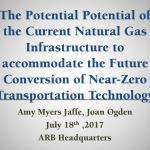
Guest Speakers: Amy Myers Jaffe, Executive Director, Energy and Sustainability, University of California-Davis and Joan Ogden, Sustainable Transportation Energy Pathways (STEPS) Director, University of California-Davis
Date : July 18, 2017
Time : 9:00 AM – 1:00 PMWebinar presentation, video, research project and interview can be found here.
- Sperling, Daniel

- Sperling, Daniel
- Daniel Sperling
- Founding Director, ITS-Davis
- Professor, Civil and Environmental Engineering
- Professor, Environmental Science and Policy
- Faculty Director, Policy Institute for Energy,
Environment and the Economy - Research Interests:Transportation technology assessment; Energy and environmental aspects of transportation; Transportation policy
- Contact Info
- 1715 Tilia Street
- (530) 752-7434
- dsperling@ucdavis.edu
- Sperling, Daniel
- An In-Depth Look At Lyft And Uber Drivers

Lyft and Uber are two of the most well-known, on-demand ride-service providers in the current landscape of shared mobility. As monthly ridership for these two services grow, researchers are left wondering about the individuals giving the rides: the drivers. This paper shifts the focus from on-demand, ride-sharing passengers to the drivers – a topic to which little attention has been paid. In August 2015, Kelley Blue Book provided a dataset from its nationwide survey of U.S. residents aged 18 to 64 that collected information on shared mobility awareness and usage, personal vehicle ownership, aspirations for future vehicle ownership, and attitudes and opinions on shared mobility and personal vehicle ownership. We estimate an ordinal logit to understand the willingness to be a driver for an on-demand ride sharing service. We find that the individuals who report higher VMT and that have more children are more willing to drive for the service. Older women with higher incomes are among the least likely to desire driving for these services. We introduce attitudinal factors and find that those who believe “Ride-sharing is better than vehicle ownership” are more willing to drive for these services. Furthermore, vehicle ownership is positively correlated with the desire to drive for on-demand ride services – owning a vehicle makes it possible for an individual to drive. The next step of this research is to develop a new survey that over samples ride-sharing drivers to better understand who is driving for these services, rather than who is willing to drive for them
Read the paper here
- Electricity
Production methods, total grid capacity, and time-of-day charging impacts on the utility sector are studied in this research area. Vehicle-to-grid recharging methods and policies are evaluated and optimized, and research is conducted on consumer behavior and preferences for electric drive attributes, including all-electric range and charging time. This research area has a strong collaboration with the UC Davis Plug-in Hybrid Vehicle Research Center.
Research Leaders: Tom Turrentine, Ken Kurani, Gil Tal, Chris Yang
- Energy, Environment, and Cost Analysis
Considerable research effort has been devoted to the analysis of energy cycle emissions of hydrogen and alternative fuels for use in transportation. In this research program, previous studies of lifecycle emissions and energy use are compared and differences explicitly specified. Energy use and emissions of air pollutants and greenhouse gases are analyzed for each alternative fuel pathway. This research features the incorporation of alternative fuel vehicles into the current Advanced Vehicle Cost and Energy Use model (AVCEM) and Lifetime Emissions Models (LEM), as well as the Social Cost Calculator (SCC).
Research leaders: Alissa Kendall, Richard Plevin
- Energy Transition and the Use of Natural Gas in Freight Transportation: Pros and Cons
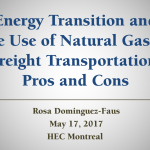
Guest Speaker :Rosa Dominguez-Faus, Program Manager, Sustainable Transportation Energy Pathways, Institute of Transportation Studies, University of California Davis
Date : Wednesday, May 17, 2017
Time : 4-5pm (Eastern Time)
Where : ON-LINE WEBINARFree event. Registration required, click here.
Summary: Natural Gas is abundant in North America and has some clean burning fuel properties. This talk will discuss the potential for natural gas to penetrate the transportation market in US, its environmental benefits, and barriers to adoption. This talk will also discuss whether natural gas could serve as a bridge to lower carbon fuels such as renewable natural gas and hydrogen. - Environmental Assessment of Natural Gas in Transportation
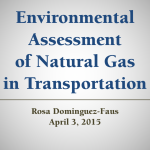
Title: Environmental Assessment of Natural Gas in Transportation
Date: April 3, 2015, 9:30 a.m. (PST)
Presenter: Rosa Dominguez-Faus
This webinar focused on research discussed in a new white paper, “The Carbon Intensity of NGV Long-Haul Trucks.” Discussion compared the carbon intensity of natural gas and diesel long haul trucks as calculated with the latest version of GREET1. It also explored the contribution of different assumptions- such as methane leakage, engine efficiency and natural gas storage- to the well-to-wheels carbon intensity of natural gas trucks. Additionally, the webinar examined how to calculate the break-even methane leakage for natural gas trucks and the extent to which renewable natural gas can improve the climate performance of NGV trucks.
To view the slides for this webinar, click here.
- Estimating Criteria Pollutant Emissions Using the California Regional Multisector Air Quality Emissions (CA-REMARQUE) Model v1.0, Geosci. Model Dev. Discuss.,
Link to study
- Exploring the Role of Natural Gas in U.S. Trucking
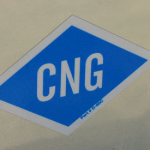
The recent emergence of natural gas as an abundant, inexpensive fuel in the United States could prompt a momentous shift in the level of natural gas utilized in the transportation sector. The cost advantage of natural gas vis-à-vis diesel fuel is particularly appealing for vehicles with a high intensity of travel and thus fuel use. Natural gas is already a popular fuel for municipal and fleet vehicles such as transit buses and taxis. In this paper, we investigate the possibility that natural gas could be utilized to provide fuel cost savings, geographic supply diversity and environmental benefits for the heavy-duty trucking sector and whether it can enable a transition to lower carbon transport fuels. We find that a small, cost-effective intervention in markets could support a transition to a commercially sustainable natural gas heavy-duty fueling system in the state of California and that this could also advance some of the state’s air quality goals. Our research shows that an initial advanced natural gas fueling system in California could facilitate the expansion to other U.S. states. Such a network would enable a faster transition to renewable natural gas or biogas and waste-to-energy pathways. Stricter efficiency standards for natural gas Class 8 trucks and regulation of methane leakage along the natural gas supply chain would be necessary for natural gas to contribute substantially to California’s climate goals as a trucking fuel. To date, industry has favored less expensive technologies that do not offer the highest level of environmental performance.
- Fall Symposium 2017
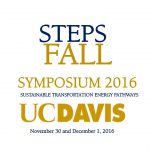
Agenda
Day 1 Presentations
Drew Kodjak. ICCT. The Prospects for Very Low Vehicles Worldwide
Guido Franco. CEC. Is California’s Energy System Resilient to Climate Change?
Obadiah Bartholomy. SMUD. Climate Readiness in the Capital Region
Joan Ogden. STEPS. Research Ideas: Transportation Fue Infrastructure Vulnerability and Resiliency to Climate Change
Marshall Miller. STEPS. Revised Transition Scenarios for California
Chris Yang. STEPS. Freight Decarbonization Comparison between CA-TIMES and the Truck Choice Model
Andy Burke. STEPS. Energy Storage with Batteries and Supercapacitors
Guozhen Li. STEPS. H2 Refueling Infrastructure for Medium- and Heavy-duty Fuel Cell Vehicles
Mollie D’Agostino.3R Future Mobility Program. Status and Updates at 3R
Giovanni Circella. 3R Future Mobility Program. Adoption of Shared Mobility and Ridehailing in California and Impacts on Use and Other Travel Modes
Lew Fulton. STEPS. The Cost of 3R: A Deeper Dive
Day 2 Presentations
Jeremy Martin. UCS. How Will Biofuel Policies Weather the Storm in DC?
Rob Williams. STEPS. Reporting on STEPS Advanced Biofuels Modeling Cost Study
Julie Witcover. STEPS. LCFS Status Report and Update on LCFS Spreading to Other States and Canada Provinces
Gil Tal. PHEV Center. Modeling the Demand for DC Fast Charging: Have we done it all wrong?
Alan Jenn. PHEV Center. Estimating the Impact of Monetary Incentives on Second Generations PEV buyers
Ken Kurani. PHEV Center. In the Slow Lane: ZEV Markets in California, June 2014 to June 2017
Posters
1. Passenger Rail – 2017 Research Update. Raphael Isaac , Paul Erickson
2. The Engine Size Tax and Its Impact on Chinese Automobile Market. Tongxin Xu, Alan Jenn, Erich Muehlegger
3. Hydrogen Demand and Refueling Infrastructure Planning for Medium- and Heavy-Duty Fuel Cell Vehicles in California. Guozhen Li, Joan Ogden
4. Hydrogen Energy Storage for Renewably Intensive Electricity Grids. Zane McDonald, Chris Yang, Joan Ogden, Alan Jenn
5. V2G and G2V smart grid optimization study in a Renewable-Fossil Based Energy System for Northern WECC. Behdad Kiani
6. Plug-in Electric Vehicle (PEV) Charging Infrastructure Assessment Overview, Approaches and Insights. Sesha Raghavan, Xinwei Li, Joan Ogden, Lew Fulton
8. Strengthening the inspection and maintenance system of in-use vehicles in India. Jai Malik, Lew Fulton
9. Truck Choice Model. Qian Wang, Marshall Miller, Lew Fulton, Christopher Yang, Joan Ogden
10. Estimating the Potential Demand for Shared Mobility in First/Last Mile Transit Using MTC Travel Demand Model. Miguel Jaller, Caroline Rodier, Elham Pourrahmani
11. Costs of Shared Mobility, Electric Vehicle Integration, Autonomous Vehicle, and Consumer Behaviors in terms of mode and vehicle choices. Junia Compostella, Lew Fulton
12. What Drives Your Drivers: An In-Depth Look at Lyft and Uber Drivers. Rosaria Berliner, Gil Tal
13. Understanding the Factors Affecting Changes in Household Car Ownership in California. Farzad Alemi, Giovanni Circella, Susan Handy, Patricia Mokhtarian
14. What We Know about the Use of Ridehailing: Frequency of Use and Impacts on Other Modes. Farzad Alemi, Giovanni Circella, Susan Handy, Patricia Mokhtarian
15. Trip analysis to determine PEV charging behavior, infrastructure placement, and charging infrastructure policy. Alex Campbell, Gil Tal
17. Considerations in the use of supercapacitors in combination with batteries in vehicle applications. Andrew Burke
18. China Low-speed Electric Vehicle Boom. Jinpeng Gao, Daniel Sperling, Yunshi Wang, Gil Tal
- Fossil Fuels
This research category includes both the “business as usual” reference case, where petroleum-based fuels continue to dominate transportation energy, and the evolution of fuels produced from other fossil fuel resources, including tar sands, oil shale, and coal with carbon sequestration. Expanded use of diesel fuel is also studied. Policies and business strategies are investigated with respect to fossil fuel research strategy, economic impacts, environmental impacts, and corporate strategic behavior.
Research Leaders: Amy Myers Jaffe, Rosa Dominguez-Faus, Cynthia Lin, Joan Ogden
2015-2018 Research Theme: Future of Fuels and the Oil and Gas Industry
Other top issue of Interest: Renewable Natural Gas
Exploring the Role of Natural Gas in U.S. Trucking
- Freight
coming soon
- From 2011–2017, the share of alternative fuels in California’s transportation energy grew from 6.1 percent to 8.5 percent. Of alternative fuel energy, the portion coming from non-liquid fuels increased from 7.6 percent to 13.5 percent over the period
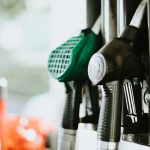
- Fulton talks about 3 Revolution at Cap Radio with Beth Ruyak

Hear the interview here
- Future Transportation Energy Water Use Under California’s Climate Goals
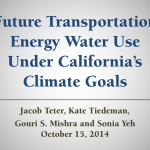
California has built a water management infrastructure that is among the most sophisticated, extensive, and energy-intensive in the world. Approximately 19% of the State’s electricity and 30 percent of its non-power plant natural gas is used to store, convey, conserve, and treat water and wastewater. Across all sectors, many energy technologies require substantial quantities of water, and have impacts on water quality.
Transportation accounts for the largest share of California’s greenhouse gas (GHG) emissions and still relies overwhelmingly (~96%) on petroleum products. As California progresses toward meeting its 2020 GHG reduction commitment and develops its 2030 target towards the 2050 goal, transportation energy sources will realize a radical shift to alternative fuel sources that might include biofuels, natural gas, electricity, and hydrogen.
This webinar, “Future Transportation Energy Water Use Under California’s Climate Goals,” held on Wednesday, October 15, discusses how climate policies can manage and reduce water use for oil production, oil refining, as well as electricity generation.
Speakers:
- Sonia Yeh, Research Scientist, ITS
- Jacob Teter, PhD Student, ITS
- Kate Tiedeman, Graduate Student Researcher, ITS
- Gouri Shankar Mishra, PhD Candidate, ITS
To read a policy brief on transportation energy water use, click here.
To read a technical brief on oil production water use, click here.
To view the presentation slides, click here.
- Tal, Gil

- Gil Tal
- Professor, Environmental Science and Policy
- Research Interests:Travel behavior, Alternative Fuel Vehicles, Travel Demand Modeling, Transportation Planning, Environmental Policy ; Non motorized transportation; Creation and use of data in transportation planning process
- Contact Info
- 1715 Tilia Street (West Village)
- (530) 752-2570
- gtal@ucdavis.edu
- Global Fuel Economy
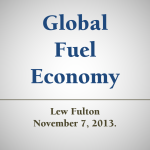
Large reductions in vehicle fuel use and CO2 emissions are needed globally in order to address pressing issues of climate change, energy security and sustainable mobility. Plug-in electric vehicles are a promising solution and sales have started, but it will take time to reach volumes that can contribute significantly to policy goals. In the meantime, fuel economy improvements from conventional internal combustion engine cars can save $2 trillion over the next ten years and can cut vehicle CO2 emissions in half by 2050, and help fund a transition to plug-in vehicles, according to a new report by ITS-Davis and the Global Fuel Economy Initiative (GFEI), a partnership of international agencies and top energy policy experts.
This webinar took place on November 7, 2013.
Speaker: Professor Lew Fulton, Co-Director of the UC Davis Sustainable Transportation Energy Pathways
Click here for the slides from Professor Fulton’s presentation
- Hearing on “21st Century Energy Markets: How the Changing Dynamics of World Energy Markets Impact our Economy and Energy Security”: Testimony of Amy Myers Jaffe
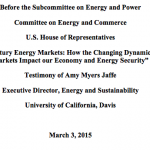
Click here for the PDF.
- How to Combine Three Revolutions in Transportation for Maximum Benefit Worldwide
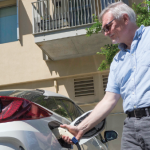
By: Lew Fulton
Three transportation revolutions are in sight, and together, they could help reduce traffic, improve safety, improve livability, and eventually save trillions of dollars each year and reduce urban transportation carbon dioxide emissions by 80 percent or more worldwide by 2050. Our new report from the Sustainable Transportation Energy Pathways (STEPS) program of ITS-Davis, done in cooperation with the Institute for Transportation & Development Policy and released May 3rd, tells us how.
• For the UC Davis press release and full “Three Revolutions in Urban Transportation” report, click here.
• For GIF/animations that show the dynamics of changes depicted in the report, click here.
• Also, for information on the ITS-Davis 3 Revolutions Policy Initiative, click here.The revolutions in question are electric vehicles, automated (driverless) cars, and shared mobility (multiple people sharing a trip, in the form of ride hailing or transit). All three of these revolutions are coming but it is not clear how fast, or which if any will dominate. But one thing is certain: to receive the most benefit from these revolutions, the most critical component is something most preschoolers know: Sharing is caring.
The report looks at how the revolutions may unfold out to 2030 and on to 2050 around the world, and delves into three urban travel scenarios surrounding the three transportation revolutions:
• Business as usual (BAU): a future without widespread electrification or automation
• “2 Revolutions:” electrification and automation are embraced but shared mobility is not
• “3 Revolutions:” electrification, automation and shared mobility are all widespreadEach revolution can provide important benefits. Electric vehicles have the potential to be near-zero CO2 emission, since they do not emit any emissions directly, and it is possible (and necessary) to decarbonize electric grids around the world over the coming decades. Automation may provide important safety benefits, particularly in the developing world where accident and injury/mortality rates today are often very high.
But the analysis and scenarios in this study find that it is shared mobility that provides the largest potential benefits, in the form of vastly reduced traffic, for starters. In fact widespread ride sharing could help move global transportation into a future that not only saves energy and emissions but also decongests highways, frees up parking spaces for other urban uses, cuts transportation costs, and improves walkability and livability.
It is important to emphasize that the use of “shared mobility” here does not include single-occupant ride-hailed Uber or Lyft vehicles, but only cases where multiple people share the ride. It also includes new forms of on-demand public transportation, such as small commuter buses with flexible routes. Active transportation, such as cycling, complements this scenario.
Benefits worldwide
The report spans eight global regions, including five major markets: United States, Europe, China, India and Brazil.
The different global regions vary considerably in their starting points. For example, the United States is highly car-dependent, whereas India’s challenge will be to preserve and enhance shared mobility options they already have. Yet, across the globe, the 3 Revolutions, or 3R, scenario holds the most environmental and societal benefit.
As shown in the figures below, the greater range of modes (on a passenger kilometers basis) in India is clearly evident compared to the U.S., but in both cases the overall travel levels are lowest in the 3R scenario, with a far higher share of shared mobility (saving even more vehicle kilometers) than in the other scenarios.
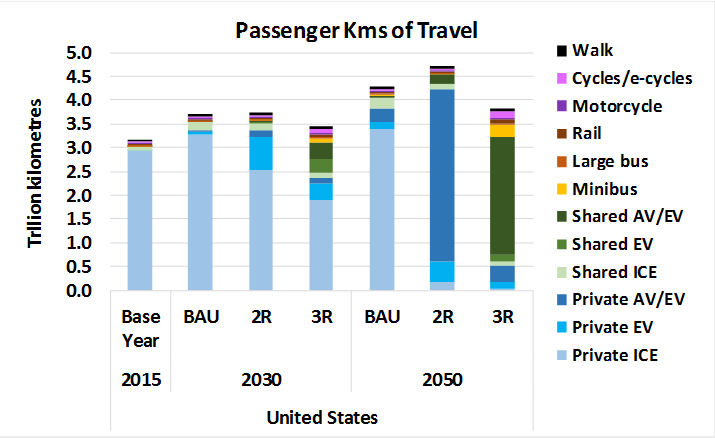
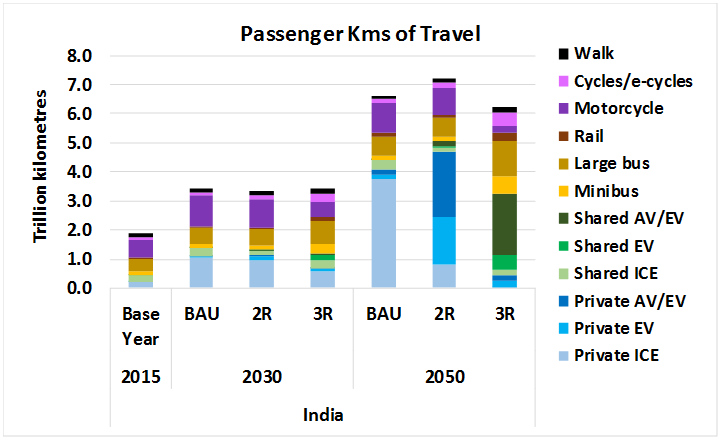
Potential pitfalls of not sharing
Without a concurrent shift away from private vehicle ownership and toward ride sharing, the potential for electric, autonomous vehicles to reduce traffic and sprawl are severely limited, and CO2 reductions will be significantly less than with sharing.
Driverless vehicles alone could actually increase traffic congestion. Imagine people spending even more time in their cars or the possibility of zero-occupant, driverless vehicles continuously circling the streets rather than parking.
Electrification is also very important. We estimate that an autonomous vehicle world without electrification or trip sharing would not cut carbon dioxide emissions at all, and might actually increase them.
The road to achieving emissions targets
The report, “Three Revolutions in Urban Transportation,” comes the week before an international climate change meeting begins in Bonn, Germany. The climate talks will focus on implementing the 2015 Paris Agreement, which targets a 2 degree Celsius or lower cap to an overall temperature change from global warming. This target requires all nations to cut their carbon dioxide emissions dramatically by 2050. We note that the “3R” scenario would meet that benchmark for cities, and possibly go further. As shown in the figure below, the global urban passenger transportation CO2 emissions about 3 gigatonnes in 2015 rises to over 4.5 gigatonnes by 2050 in our BAU scenario, whereas it drops to below 2 in our 2R scenario (mainly due to electrification) and to below 1 gigatonne in 3R (due to much greater use of transit, non-motorized modes, and ridesharing in that scenario. It is also less dependent on decarbonized electricity to reach its 2050 level.

The effects of 3R on travel, and the numbers of light-duty vehicles, are shown in the figure below. Due to the much more intensive use of each commercial, shared vehicle, along with greater use of transit and non-motorized modes and a general reduction in trip lengths due to more compact cities, results in more than a 2/3 reduction in the stock of LDVs worldwide (and, as shown here, in the U.S.) in 2050 compared to the peak level in 2025 (and 75% below the peak reached in 2R). This opens up tremendous possibilities for re-tasking land use, such as for more bike lanes, more dense development (given fewer parking lots) and other changes to cityscapes.

3R would cut transportation costs by $ trillions
Perhaps the most surprising result is that the 3R scenario costs far less to society by 2050 than the 2R scenario, with savings beginning around 2030 and increasing per year to reach over $5 trillion per year worldwide in 2050. This includes savings in fuel costs, the costs of new vehicle purchases (given dramatically lower sales and stocks of vehicles), and the costs of building and maintaining road and parking infrastructure. Even higher expenditures on better and more extensive transit systems do not offset the other savings very much.
We recognize that bringing about these revolutions won’t be easy. The report outlines needed policies, and says unprecedented levels of policy support and coordination are needed at the local, state and national levels.
The report assesses policies including those that incentivize widespread adoption of electric and driverless cars, as well as support for ride sharing, public and active transport, and land-use planning that helps shorten most vehicle trips. Such policies could consider fees tied to vehicle CO2 emissions, vehicle occupancy, and possible restrictions or heavy charges on private ownership of autonomous vehicles, along with strong disincentives for zero-occupant trips. Bicycle and e-bike sharing systems also need to be encouraged along with transit system innovations.
The report was funded by ClimateWorks Foundation, William and Flora Hewlett Foundation, and Barr Foundation.
- Hydrogen
 Hydrogen has been widely proposed as a long term option to address environmental and energy security problems posed by current transportation fuels. Hydrogen fuel cell cars are several times more efficient than today’s conventional gasoline cars, and they produce zero tailpipe emissions. They offer good performance, a range of 300-400 mile, and can be refueled in a few minutes. Hydrogen can be made with zero or near-zero emissions from widely available resources, including renewables (like biomass, solar, wind, hydropower, and geothermal), fossil fuels (such as natural gas or coal with carbon capture and sequestration), and nuclear energy. In principle, it should be possible to produce and use hydrogen transportation fuel with near-zero well-to-wheels emissions of greenhouse gases and greatly reduced emissions of air pollutants while simultaneously diversifying away from our current dependence on petroleum.
Hydrogen has been widely proposed as a long term option to address environmental and energy security problems posed by current transportation fuels. Hydrogen fuel cell cars are several times more efficient than today’s conventional gasoline cars, and they produce zero tailpipe emissions. They offer good performance, a range of 300-400 mile, and can be refueled in a few minutes. Hydrogen can be made with zero or near-zero emissions from widely available resources, including renewables (like biomass, solar, wind, hydropower, and geothermal), fossil fuels (such as natural gas or coal with carbon capture and sequestration), and nuclear energy. In principle, it should be possible to produce and use hydrogen transportation fuel with near-zero well-to-wheels emissions of greenhouse gases and greatly reduced emissions of air pollutants while simultaneously diversifying away from our current dependence on petroleum.Researchers are exploring new areas such as hydrogen/electricity systems, regional transition case studies, understanding the impact of alternative policies, and enhancing key hydrogen pathways models for infrastructure development strategies. Additional work focuses on the interaction between hydrogen and existing infrastructure, such as electricity and natural gas. This work expands upon the research from the earlier Hydrogen Pathways Program (archived webpage).
Research Leaders: Joan Ogden, Michael Nicholas, Chris Yang
The Hydrogen Transition
- White Paper (57 Pages)
- Executive Summary (8 Pages)
- Webinar July 30, 2014
- HydrogenHydrogen
- Infrastructure System Analysis
The goal of this research is to develop a detailed understanding of production facilities and infrastructure at different scales for biofuels, electricity, hydrogen, conventional, and unconventional liquid fuels using tools and models being developed including geographical information systems (GIS), mathematical programming tools, and engineering economic models for infrastructure components. This research also includes an assessment of key inputs such as water, energy resources, electricity, and land.
Research Leaders: Christopher Yang, Yueyue Fan
- Innovation and Business Strategy
Policy and Business Strategy researchers are developing an understanding of the role of the policy process on the potential transition to an alternative fuel-based transportation system. The research contains a number of projects focused on: the policy process surrounding alternative fuels; evaluation of policy alternatives and their likely implications for the transition; and the development of business strategies for an alternative fuel based economy. Researchers are employing a variety of tools to assess these complex issues including policy development frameworks, microeconomic theory and modeling.
Research Leaders: Amy Myers Jaffe, Andrew B. Hargadon
- Integrative Scenarios
The objective of this research is to incorporate quantitative results from a range of STEPS projects to develop integrated, self-consistent and insightful scenarios of possible transportation futures. The quantitative models applied within this research will vary in complexity, but they are likely to be of two types: bottom-up or top-down. The bottom-up VISION model (from Argonne National Lab) is currently being applied to evaluate the introduction of AFVs Nationally and in California. A second potential bottom-up model is the MARKAL model. As the STEPS Program evolves, a top-down or economic model may also be incorporated to support scenario development (such as the NEMS, MINICAM, BEAR or AMIGA models, or a Systems Dynamics model such as HyDIVE).
Research Leaders: Joan Ogden, Sonia Yeh, Lew Fulton, Christopher Yang
- Jenn, Alan

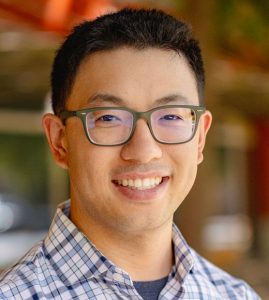
- Alan Jenn
- Assistant Professor
- Research Interests:Alternative fuel vehicle adoption; Transitions to sustainable energy systems; Quantitative policy analysis; Big data statistical analysis
- Contact Info
- ajenn@ucdavis.edu
- Ogden, Joan
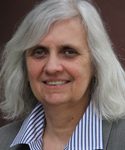
- Joan Ogden
- Professor, Environmental Science and Policy
- Director, NextSTEPS (Sustainable Transportation
Energy Pathways) - Research Interests:Technical and economic assessment of new energy technologies; Modeling hydrogen infrastructure development
- Contact Info
- 1715 Tilia Street
- (530) 752-7659
- jmogden@ucdavis.edu
- Joan Ogden, Amy Jaffe, Daniel Scheitrum, Zane McDonald, Marshall Miller, “Natural Gas as a Bridge to Hydrogen Transportation Fuel, Insights From The Literature ” accepted for publication, Energy Policy special issue on Natural Gas in Transportation, December 1, 2017.Joan Ogden, Amy Jaffe, Daniel Scheitrum, Zane McDonald, Marshall Miller, “Natural Gas as a Bridge to Hydrogen Transportation Fuel, Insights From The Literature ” accepted for publication, Energy Policy special issue on Natural Gas in Transportation, December 1, 2017.
- Joan Ogden discusses Hydrogen fuel and Fuel Cell Vehicles in Watts Radio Interview
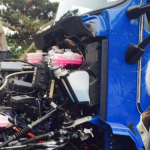
Hear the Interview
- Witcover, Julie

- Julie Witcover
- Assistant Project Scientist, UC Davis
- Research Interests: Indirect land use effect of biofuels policy
- Contact Info
- jwitcover@ucdavis.edu
- Kurani, Ken
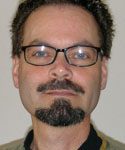
- Ken Kurani
- Associate Researcher, ITS-Davis
- Graduate Adviser, Transportation Technology and
Policy Graduate Group - Research Interests:
Household response to alternative fuel and electric-drive vehicles; Energy, climate, and environment in household travel choices; Behavioral theory in transportation and energy
- Contact Info
- 1605 Tilia St. (West Village), Rm 100
- knkurani@ucdavis.edu
- Fulton, Lew

- Lew Fulton
- Co-Director, STEPS (Sustainable Transportation Energy Pathways)
- Research Interests:International transport and energy policy; Transportation technology potential, costs and benefits; Global energy transition modeling
- Contact Info
- 1715 Tilia Street (West Village)
- (530) 752-3004
- lmfulton@ucdavis.edu
- Lew Fulton Talks Transportation in Watts Radio Interview
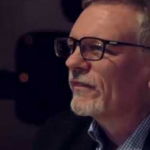
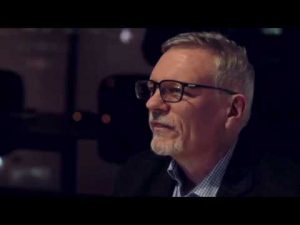
Hear the interview
- Lew Fulton on Fuel Strategies Podcast

- Lew Fulton discusses Automation and Freight at Watts Radio

Listen to interview here
- Low Carbon Energy Generates Public Health Savings in 2 California
ZAPATA OGDEN LOW CARBONacp-2017-796
- Kleeman, Michael

- Michael Kleeman
- Professor, Civil and Environmental Engineering
- Research Interests:
Study of urban and regional air quality problems; Composition of atmospheric particles and gas-to-particle conversion processes
- Contact Info
- 3125 Ghausi Hall
- (530) 752-8386
- mjkleeman@ucdavis.edu
- Jaller, Miguel

- Miguel Jaller
- Assistant Professor, Civil & Environmental Engineering
- Research Interests: Industrial and Transportation Engineering; Sustainable Transportation Systems; Humanitarian Logistics; Supply Chain Management; Operations Research
- Contact Info
- 2001 Ghausi Hall, 3143
- (530) 752-7062
- mjaller@ucdavis.edu
- Mobility and Travel Behavior
This area of research focuses on how individuals’ attitudes, values, and preferences affect their travel behavior in different communities. Personal travel behavior can be influenced by a multitude of factors including, but not limited to personal and household characteristics, work schedule, distance, etc. Along with these factors, and many others, travel is also dependent on mobility. Thus, it is also important to consider other factors that can affect mobility, such as infrastructure availability, urban elements, transport modes available, etc. Understanding travel behavior as well as personal mobility will allow for a better understanding of different individuals’ transportation patterns.
Research Leader: Susan L. Handy, Caroline Rodier - Natural Gas as a Bridge to Hydrogen Transportation Fuel?


Natural gas has been proposed as a possible “bridge” fuel to eventual use of hydrogen in zero emission fuel cell vehicles. This literature review explores whether the natural gas system might help enable a transition to longer-term use of hydrogen in transportation. Two transition strategies are reviewed: adapting natural gas refueling infrastructure for future use with H2 and blending renewable hydrogen into the NG system.
Our review suggests it is not attractive to re-purpose or overbuild NG fueling station equipment for future hydrogen service. Transporting H2/NG blends in the NG pipeline grid appears technically possible at modest fractions of 5–15% hydrogen by volume, but requires careful case by case assessment and could be expensive. Blending does not enable major reductions in GHG emissions from transport, unless “green” hydrogen can be cost effectively separated from the blend and delivered to highly efficient fuel cell vehicles. Ultimately, blend limits could make it difficult to utilize the existing NG system to deliver hydrogen at the scale needed to achieve deep cuts in transportation related GHGs. A dedicated renewable hydrogen system would be needed, if zero emission fuel cell vehicles play a major role in a future low carbon world.
Read the Blog here
Watch the webinar here
Read the full report here
- Natural gas and Renewable Natural GasNatural gas and Renewable Natural Gas
- New research on how ride-hailing impact travel behavior By Regina R. Clewlow, Ph.D.

This article first appeared on Planetizen at www.planetizen.com
Useable data of the effects of ride-hailing service on travel behavior is sorely lacking, but a new study sheds light on critical questions about what companies like Uber and Lyft mean for transit, active transportation, and congestion.
A new report on the adoption and use of ride-hailing finds that services like Uber and Lyft attract passengers away from public transit, biking, and walking, in addition to serving as a complementary mode (e.g., for commuter rail). The UC Davis Institute of Transportation Studies research is the first-ever study with representative data from major cities across America on ride-hailing and its impact on travel decisions.
Ride-hailing services like Uber and Lyft are clearly shaping the way that people move in major cities. However, due to their rapid rise in popularity, the relatively slow pace of regulation, and lack of available data on how, when, and why people use these services, city planners and transportation researchers have been limited in their ability to provide insights into how ride-hailing is changing travel choices and plan for the future. The downside is that those who are responsible for making important long-range decisions about transportation infrastructure and vehicle fleets (e.g., auto manufacturers) are essentially operating in the blind without data.
The new report was produced by researchers at the University of California, Davis Institute of Transportation Studies — one of five leading national transportation research centers funded by the U.S. Department of Transportation.
Uber and Lyft most likely add to traffic in major cities today
In this study based on data collected in major cities across America, we found that a large portion of travelers are substituting ride-hailing in place of public transit, biking, and walking trips, or would not have made the trips at all (Fig. 1). These trips, which are being substituted for or generated by ride-hailing, are most likely adding vehicles to the road in major metropolitan areas. There is a significant need for future research on the topic — the most recent findings from major cities seem to suggest that ride-hailing is likely adding to, not reducing traffic congestion.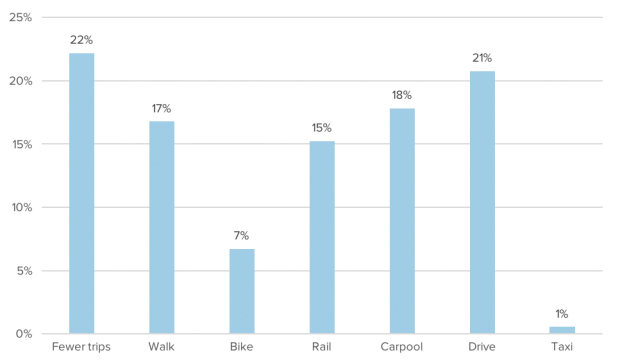
Figure 1. How ride-hailing users would travel if Uber or Lyft were unavailable.The research (and ride-hailing firms themselves) suggest that ride-hailing can be complementary to public transit. This is also true. However, this study finds that while some portion of individuals increase their transit use (an increase in commuter rail use), the net effect across the entire population is an overall reduction in public transit use and a shift towards lower occupancy vehicles (i.e. more cars).
The broader implications of this shift in travel choice are critical. Cities are grappling with how to plan for the potential introduction of autonomous vehicles, which many believe will be deployed through shared services, not to mention the ever-rising impacts of the transportation sector on energy use and emissions. As of 2016, transportation surpassed the power sector as the largest contributor to the U.S. climate problem.
Many believe that sharing vehicles can help address our growing transportation woes — however, this research shows that sharing vehicles is not enough. We will likely need to foster more dense development patterns that can minimize vehicle miles traveled through walkable and bike-friendly neighborhoods, continue to invest in mass transit, and facilitate shared rides in shared vehicles through pricing or incentives.
With the right model, it is also possible that ride-hailing could serve as an effective solution in existing suburban areas where personal vehicles dominate travel. However, without significant coordination between cities, public transit agencies, and ride-hailing services themselves, we do not believe this optimistic scenario is likely to materialize. It hasn’t thus far.
Evolution of shared mobility services
Much of prior academic research on impacts of shared mobility services study what we term carsharing 1.0 — that is, early models of carsharing where vehicles were picked up and returned to the same location, typically through hourly rentals (Fig. 2). A key takeaway from this recent report is that not all shared services can be viewed as the same.The adoption rates of ride-hailing far outpace the adoption rates of prior carsharing models. Older business models of carsharing have attracted only 2 million members in North America and close to 5 million globally — over roughly 15 years. Conversely, the adoption ride-hailing (e.g., Uber, Lyft, Didi), the latest model of “shared mobility” is estimated to have grown to more than 250 million users globally within their first five years of existence.
Prior research shows that carsharing members (e.g. Zipcar, car2go) were highly educated and environmentally oriented. We believe that the widely cited vehicle reduction “impacts” of carsharing were more likely due to self-selection bias rather than a significant causal relationship. Early carshare members were motivated to reduce their environmental footprint, and they represent less than 1% of the entire U.S. population.
Ride-hailing, on the other hand, has captured a much broader swath of the population. Interestingly, but perhaps not surprisingly, we find that more than half of carsharing users surveyed dropped their membership, with 23% citing their use of services like Uber and Lyft as the top reason they no longer use carsharing.
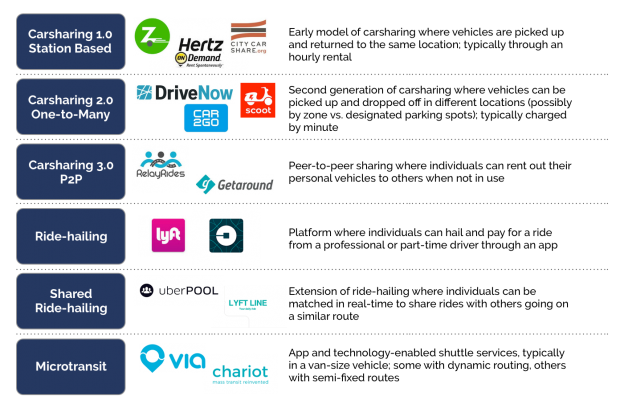
Figure 2. The evolution of shared mobility services.Reduced vehicle ownership and reduced carsharing membership
The research study reveals a number of additional insights into the travel decisions made by individuals and households, including the demographics of typical ride-hailing adopters, frequency of ride-hailing use, and vehicle ownership decisions.Key findings include the following:
Nearly a quarter (24%) of ride-hailing adopters in metropolitan areas use ride-hailing on a weekly or daily basis.
Parking represents the top reason that urban ride-hailing users substitute a ride-hailing service in place of driving themselves (37%).
College-educated, affluent Americans have adopted ride-hailing services at double the rate of less educated, lower income populations.
Among adopters of prior carsharing services, 65% have also used ride-hailing. More than half of them have dropped their membership, and 23% cite their use of ride-hailing services as the top reason they have dropped carsharing.
Ride-hailing users have higher personal vehicle ownership rates than those who use “transit only”: 52% versus 46%.
Among non-transit users, there are no differences in vehicle ownership rates between ride-hailing users and traditionally car-centric households.
Those who have reduced the number of cars they own and the average number of miles they drive personally have substituted those trips with increased ride-hailing use. Net vehicle miles traveled (VMT) changes are unknown.
After using ride-hailing, the average net change in transit use is a 6% reduction among Americans in major cities.
As compared with previous studies that have suggested shared mobility services complement transit services, the substitutive versus complementary nature of ride-hailing varies greatly based on the type of transit service in question. On average, ride-hailing hailing appears to reduce bus ridership and complement commuter rail.
49% to 61% of ride-hailing trips would have not been made at all, or by walking, biking, or transit.
Directionally, based on mode substitution and ride-hailing frequency of use data, ride-hailing is currently likely to contribute to growth in vehicle miles traveled (VMT) in the major cities represented in this study.
The full report can be downloaded through the ITS website.Regina Clewlow, PhD is a leading transportation researcher on shared mobility and autonomous vehicles. She received her Ph.D. from MIT in Transportation Systems, and has served as a research scientist at UC Berkeley, Stanford, and UC Davis. Dr. Clewlow joined the transportation startup world where she was previously the Director of Business Development and Strategy at Ridescout (acquired by Daimler and rebranded as moovel). To learn more about how to access new urban mobility insights sign up here, or contact her via LinkedIn.
- Paris Climate Accord: A Strong Call to Action, Including Transportation

By: Lew Fulton
The Paris Climate Accord reached on Saturday, December 12, feels like a home run. Nearly 200 countries fully agreed on text in which they pledge to make large reductions in greenhouse gas emissions over the next 15 years, with mechanisms to help ensure that this goal is achieved. It includes quantified CO2 mitigation commitments from all major economies around the world; mechanisms for reporting and verifying progress; commitments for $100 billion in financing of actions; and many other key elements.
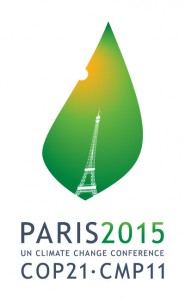 However, as President Obama said in his speech that day, this agreement does not “solve” the global climate change problem.
However, as President Obama said in his speech that day, this agreement does not “solve” the global climate change problem.“Even if all the initial targets set in Paris are met, we’ll only be part of the way there when it comes to reducing carbon from the atmosphere, so we cannot be complacent.”
The president is correct: This is only a partial solution that does not (yet) limit temperature change to 2 degrees Celsius, and it needs to be fully implemented over the coming years, with all the uncertainties around that. But it does contain many promising elements. For example, it includes specific pledges from most of the signatories to cut CO2 emissions by 2030. These commitments vary widely, as do each country’s circumstances.
What’s the outlook for transportation? Last week I noted some of the measures that feature in the Intended Nationally Determined Contributions (INDCs) of a range of countries. Today I’ll show a comparison of actual targets under the accord, with one possible scenario for transport. This is highly speculative since few countries have indicated the sectoral breakdowns of their targets; for example, even countries shooting for 40% reductions in CO2 emissions have not indicated if that means 40% in each sector (transport, buildings, industry, electricity generation, etc.) or 40% on average with individual sectors varying. But if you take for a moment the possibility that transportation delivers reductions at an average intensity, you can gain a sense of the challenge ahead.
The first figure below shows the 2014 estimated energy-related CO2 emissions for six major economies, and the 2030 target (taken as the midpoint in cases where a range of targets is possible, based on analysis presented here). The second figure shows hypothetical targets if transportation CO2 were reduced in the same proportion as the overall targets for each country, starting from 2014 transportation CO2 emissions as estimated by the International Energy Agency.
As you can see in the first figure, the U.S. commitment is ambitious – a major reduction from nearly 20 tons per capita to less than 13 by 2030. As shown in the second figure, if the U.S. reduced transportation-related CO2 emissions in proportion to this total, it would be a cut from about 6.5 tons per capita to about 4.5 by 2030.
This would still leave the U.S. at a higher per-capita emissions level than any of the other countries or regions shown. But it certainly would put the U.S. on a strong downward trajectory. China and India would actually increase their per-capita transportation emissions, but not by as much as would have occurred without their commitments – and both would remain at a very low CO2 level in 2030. Russia would retain a more average position; though Russia is noticeable in its overall target (Figure 1) in that it starts with fairly high emissions and these increase significantly – it would become the highest per capita of the six countries by 2030.
Whether or not countries decide to tackle transportation at the same level of intensity as other sectors, they will need to include ambitious goals for transportation to succeed. How will they achieve targets like these and move from planning to doing?
“You have to do many different things and each place it’s different,” noted California Governor Jerry Brown in Paris.
Among the combinations of measures that make sense for most countries to include: promote much better fuel economy of new cars and trucks (and also of second-hand imports, for those countries that import many such vehicles); shifts of travel from high CO2 modes (like cars and trucks) to lower CO2 modes (mass transit, cycling and walking, along with more rail freight). Alternative fuels will also need to play an expanding role. The only three potentially very low-emission fuels are electricity, hydrogen and biofuels, and these will need to lead the way to very low CO2 emissions. International aviation and shipping are particular challenges, since they are not covered under individual country commitments. The international bodies International Civil Aviation Organization (ICAO) and International Maritime Organization (IMO) have been asked to redouble their efforts to work with industry on commitments and strategies for these sectors, and they too will need to put a large emphasis on efficiency and alternative fuels.
The best combination of measures will vary by country, as will the role of transportation in achieving overall CO2 targets. During 2016, the STEPS program at UC Davis will be looking more closely at the plans of different countries and assessing combinations of transportation measures that can help get the job done.
All told, the U.N. Framework Convention on Climate Change Conference of the Parties (COP21) in Paris was the subject of exhaustive negotiations (and a 31-page agreement); extensive coverage in traditional media; and enormous attention on social media.
What’s yet to be written is whether the conference ultimately achieves its lofty goal: ensuring a “shared future and shared environment” for our planet.
- Policy Analysis
We are developing an understanding of the role of the policy process on the potential transitions to alternative fuel-based transportation systems. Research contains projects focus on the policy process surrounding alternative fuels and evaluation of policy alternatives and their likely implications for the transition. Researchers employ a variety of tools to assess these complex issues, including policy development frameworks, microeconomic theory and modeling.
Research Leaders: Daniel Sperling, Sonia Yeh, Julie Witcover
- Professor Sperling talks to the Union of Concerned Scientists about the 3Revolutions in Transportation: Electrification, Automation and Sharing
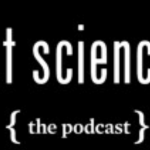
https://soundcloud.com/gotscience/ep-37-revolution-on-the-road-the-shift-to-evs-and-self-driving-cars
- Registrants to Symposium Spring2018
- Spring Symposium 2018
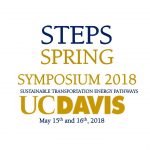
Day 1
8:30 a.m. Registration and Coffee
9:00 a.m. Welcome and Introductory Remarks
- Joan Ogden, Director, STEPS Program
9:10 a.m. Session 1: California Targets 2030-2050 (recap of CCPM3)
- Moderator: Lew Fulton, Co-Director, STEPS
- Robert Bienenfeld, Assistant Vice President, Environment and Energy Strategy at American Honda Motor Company
- Michael Coates, CEO, Mightycomm
- Colin Murphy, Policy Advocate, NextGen Policy
- Austin Brown, Executive Director, Policy Institute for Energy, Environment and the Economy, UC Davis
10:10 a.m.Keynote: Big Data, Data Analytics and Transport Modeling
Sonia Yeh, Professor, Chalmers University
10:40 a.m. Coffee Break
11:00 a.m Session 2: Grid Integration of EVs
- Moderator: Joan Ogden
- Grid Impact Modeling for Large Scale Penetration of Zero Emission Vehicles in California
Behdad Kiani, Assistant Project Scientist, STEPS - The Future of Electric Vehicle Emissions in the US
Alan Jenn, Researcher, Plug-In Hybrid & Electric Vehicle Research Center
- Discussants:
- Daniel Hopper, Senior Manager of Strategy, Southern California Edison
- Lisa Snapp, Director of the Climate Analysis and Strategies Center, US Environmental Protection Agency
12:15 p.m. Lunch and Poster Session
- STEPS students and researchers present in poster format
2:15 p.m. Session 3: Trucking and Logistics
- Moderator: Lew Fulton
- Last Mile Delivery and Automated Trucks
Hanjiro Ambrose, PhD Candidate, UC Davis - An Update on California Transition Scenarios
Marshall Miller, Senior Development, Engineer, STEPS
- Discussants:
- Jimmy O’Dea, Senior Vehicles Analyst, Union of Concerned Scientists
- Sarah Flick, Corporate Development Manager, Westport Fuel Systems
3:30 p.m. Coffee Break
3:45 p.m. Session 4: Perspectives on Hydrogen Infrastructure Developments
- Moderator: Joan Ogden
- Stephen Ellis, Fuel Cell Vehicle Marketing Manager, American Honda Motor Company
- Jean Baronas, Supervisor Hydrogen Unit, California Energy Commission
- Wayne Leighty, Hydrogen Fuel Business Development Manager, Shell
- Discussant: Robert Wimmer, Director of Energy and Environmental Research Group Toyota Motor North America
5:00 p.m. Day 1 Wrap Up
- Joan Ogden
5:30 p.m. Reception at City Hall Tavern-Bistro 33 (226 F Street, Davis, CA 95616)
Day 2
8:30 a.m. Registration and Coffee
9:00 a.m. Session 5: Three Revolutions (3Rs)
- Moderator: Austin Brown, Executive Director, UC Davis Policy Institute for Energy, the Environment, and the Economy
- Summary of 3R Conference held February 2018 and other 3R Updates
Mollie D’Agostino, 3 Revolutions Future Mobility Policy Director, ITS-Davis - California Panel Study of Emerging Technologies and Transportation Trends
Giovanni Circella, 3 Revolutions Future Mobility Program Director, ITS-Davis - The Cost of 3 Revolutions: a Deeper Dive
Lew Fulton, STEPS co-Director
- Discussants:
- Ken Laberteaux, Senior Principal Scientist, Toyota
- Adam Gromis, Public Policy Manager, Sustainability & Environmental Impact, Uber
10:15 a.m. Coffee Break
10:30 a.m. Session 6: EV Market Update
- Moderator: Gil Tal, Researcher, PHEV Center
- Comparison of ZEV mandates in California and China
Yunshi Wang, Director, China Center for Energy and Transportation, ITS-Davis - Buyers and Market Demand in California, US and China
Gil Tal, Research Director, PHEV Center - Gender Differences in Plug-in Electric Vehicles Purchasing Patterns
Ken Kurani, Researcher, PH&EV Center
- Discussant: Kadir Bedir, EV Infrastructure Specialist, California Energy Commission
11:45 a.m. Day 2 Wrap Up and Closing Remarks
- Lew Fulton
12:00 p.m. Boxed Lunch and Adjourn
STEPS Spring Board of Advisors Meeting
May 16 2018
Founders Room
Alumni Center
Agenda
12:45 p.m. Arrival and Coffee
12:55 p.m. Group Photo
1:00 p.m. Discussion Items
- STEPS3 wrap up
- Setting the Stage for STEPS4
- New sponsorship structure
- Tower System presentations
3:15 p.m. Concluding Remarks
3:30 p.m. Adjourn
Dr. Yeh is Professor in Transport and Energy Systems in the Department of Space, Earth and Environment at Chalmers University in Sweden. Her expertise is in energy economics and energy system modeling, alternative transportation fuels, sustainability standards, technological change, and consumer behavior and urban mobility. Between 2007 and 2014, she co-led a large collaborative team from the University of California Davis and UC Berkeley advising the U.S. states of California and Oregon, and British Columbia, Canada to design and implement a market-based carbon policy (Low Carbon Fuel Standard (LCFS) and Clean Fuel Standard (CFS)) targeting GHG emission reductions from the transport sector. She received Academic Federation Award for Excellence in Research by the UC Davis in 2014 and was appointed as Adlerbertska visiting professor at Chalmers University of Technology in 2015. She served as Fulbright Distinguished Chair Professor in Alternative Energy Technology in 2016-2017. - 2030 Targets STEPS Workshop (May 2015)

May 12-13, 2015 at UC Davis
Agenda
Handouts
- STEPS 2015 Project List
- Strategies for Transitioning to Low-carbon Trucks in US (Fulton Miller) Draft Exec Summ 11May2015
Presentations (Day 1 Workshop)
- Lew Fulton -STEPS Targets Workshop Introduction
- Session 1_David Daniels, US DOE – aeo2015
- Session 1_Rob Gardner, ExxonMobil
- Session 2_Jake Ward, US DOE
- Session 2_Catherine Reheis-Boyd, WSPA
- Session 3_Mike Hartrick, FCA (with copyright)
- Session 3_James Ellis, PG&E
- Session 3_Jennifer Rumsey, Cummins
- Session 4_Roland Hwang, NRDC
- Session 4_Alex Keros, General Motors
- Closing Session_Dan Sperling, ITS-Davis
- STEPS Fall 2015 Symposium (Dec. 2015)
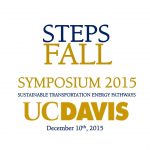
December 10, 2015
Packet: Agenda, Poster List, 2015 Projects, Attendees
Presentations
- Ogden – Intro to STEPS Symposium
- Simon – Smart Moblity, Factors Driving Sustainable Transportation
- Fulton – Future Mobility Initiative
- Fulton (Circella) – Travel Behavior of Gen Y
- Yang – CA-TIMES GHG Reduction Scenarios
- Fulton – Global PEV Market
- Tal – Impact of Incentives on PEV Market
- Jaffe – Oil Price Cycle and Peak Oil Demand Scenarios
- Witcover – Lookback at Lookback Workshop (Link to Dec. 9 workshop)
- Miller – Truck Technology Transitions with a Decision Choice Model
- Burke – Modelling and Analysis of Plug-in Series-Parallel Hybrid Vehicles
Posters
- 1. CA-TIMES
- 2. CA-TIMES Air Quality and Health
- 3. COCHIN-Consumer Choice Integration in Times
- 4. Spatial regional consumer choice and fueling infrastructure model
- 5. China’s Oil Demand
- 6. Tempering Overstated Oil Demand Project
- 8. Biofuel Innovation Tracker
- 9. Life Cycle Performance of Renewable Diesel Production from Microalgae
- 10. Battery LCA
- 11. EV Innovation
- 12. VGI – A case study of dynamic pricing (SMUD)
- 13. New concepts in vehicle control development
- 14. LTO Batteries and Supercapacitors
- 15. Series Parallel Hybrid Vehicles
- 16. Electrification of Drayage Trucks
- 17. HD Truck Technology Transitions with a Decision Choice Model
- 18. Improving Freight Efficiency in California
- 19. Demand Management for passenger and freight traffic
- 20. Rail Propulsion Technologies
- 21. Introduction to STEPS 2016 Aviation Project
- 22. A Global High Shift Cycling Scenario
- 23. CVRP funding mechanisms
- 24. PEV Dealer Study
- STEPS Fall 2016 Symposium

The STEPS team gathered 150 expert stakeholders and presented 2016 research results to date and a preview of 2017 projects.
Agenda Packet – STEPS Symposium Fall 2016
Presentations
Day One – November 30, 2016
David Ory, MTC – Keynote Travel Behavior, Now and Next
Dan Sperling, ITS-Davis – Session 1 The Three Transportation Revolutions
Lew Fulton, STEPS – Session 1 Three revolutions global project – initial findings
Lew Fulton, STEPS – Session 2 COP-22 Two Degrees and Beyond
Joshua Miller, ICCT – Session 2 iTEM-2 Conference Modeling results: What does it tell us about 2 degree scenarios?
Colin Murphy, NextGen – Session 2 Sub-National Approaches to Sustainable Transportation Policy
Daniel Scheitrum, STEPS – Session 3 RNG potential in CA: NG as an Enabler of Low Carbon Fuels
Joan Ogden, STEPS – Session 3 Hydrogen compatibility in the NG system
Chris Yang, ITS-Davis – Session 4 California transition modeling update
Kalai Ramea, ITS-Davis – Session 4 Spatial regional consumer choice and fueling infrastructure modelDay 2 – December 1, 2016
Mike Nicholas, PH&EV Research Center – Session 5 eVMT in the household fleet: evidence from year-long data collection of PEV household travel and charging
Gil Tal, PH&EV Research Center – Session 5 Secondary markets for PEVs in California
Andy Burke, ITS-Davis – Session 6 The fuel economy of MD/HD trucks 2015-2050
Marshall Miller, ITS-Davis – Session 6 Update on HDV Scenarios
Jinpeng Gao, ITS-Davis – Session 7 Low-Speed Electric Vehicles in China: Market Boom,
Miguel Jaller, UC Davis – Session 7 Shared Mobility in First/Last Mile Transit AccessPosters
-
- Alternative Vehicle Supply and Demand, and the Effects of Government Policy
-
- What Makes Travelers Use Uber: Exploring the Latent Constructs behind the Use of On-Demand Ride Services
-
- A Beginning Look at Rail Scenarios out to 2050
-
- Californian Millennials Drive Smaller Cars:Estimating Vehicle Type Choice of Millennials
-
- 3 Revolutions
-
- Renewable Natural Gas and the LCFS
-
- PHEV Vehicle Performance Simulation and Optimization
-
- BEV Consumer Behavior in Practice: Comparison of BEV Usage to ICE Usage in Multi-Vehicle Household
-
- Electrified Transportation in China
-
- Modeling the interactions between the electric vehicles for transportation and renewable intensive electricity grids in California and the Western US
-
- Modeling and analyzing near term transitions to alternative fueled vehicles using a spatial regional consumer choice and fueling infrastructure model
-
- Long-Term Gasoline Refueling Behavior and its Implication for Building a Hydrogen Refueling Network
-
- Sustainable Hydrogen Fueling/DC Fast Charging Systems at California Highway Rest Stop Areas
-
- The Fuel Economy of MD/HD Trucks 2015-2050
- The Biofuel Innovation Tracker
-
- STEPS Lookback Analysis Workshop

- STEPS Spring 2015 Symposium
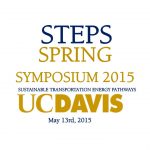
Presentations
- Session 1_Gruber STEPS Overview
- Session 1_Joan Ogden, Transition Costs
- Caltrans’ Strategic Plan 2015-2020
- Session 1_Yeh, EMF Natural Gas
- Session 1_Nathan Parker, ITS-Davis
- Session 1_Fulton GUSTO track
- Session 1_Tal, Travel Data
- Session 1_Fulton iTEM
- Session 1_Yeh MAVRIC
- Session 2_Sonia Yeh, ITS-Davis
- Session 2_MikeTamor, Ford (with copyright)
- Session 2_Rodier, Dynamic Ridesharing
- Session 2_ Jeff Gonder, NREL
- Session 3_David Kayes, Daimler Trucks NA
- Session 3_Lisa Mirisola, SCAQMD
- Session 3_Miguel Jaller, UC Davis
Posters
- 1. CA-TIMES Model
- 2. COCHIN-Times
- 3. Complex Air Quality Implications from Low Carbon Energy Scenarios for CA in 2050
- 4. Evaluating Policy Efficacy-What should we invest in
- 5. Feebates and Household Impacts in California
- 6. Generation Y Travel Survey
- 7. Understanding urban development and transport in Indian cities
- 8. Analysis and Scenarios of Low-Carbon Options for Heavy Duty Trucks
- 9. Rail Energy Update-Options for Passenger and Freight Rail Propulsion
- 10. Dynamic Optimization of Natural Gas Refueling Infrastructure for Freight Trucks
- 11. Emerging Biofuel Pathways in Policy (2 projects)
- 12. Modeling Grid Impacts of PEV Deployment-Case Study of Sacramento Region
- 13. Infrastructure Planning for Public Fast Charging Stations in a Competitive Market
- 14. Overview of Tesla Battery Electric Vehicle Adopters
- 15. Life Cycle Assessment of EV Traction Batteries
- 16. Global EV Scenarios
- 17. Integration of Sustainable Fueling or Charging Stations with Grid
- 18. Advanced Vehicle Technology Studies for STEPS 3
- 19. Hydrogen stations and the market
- STEPS Spring 2016 Symposium
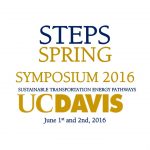
The STEPS team gathered 150 expert stakeholders and presented 2015 research results and progress on 2016 projects. We also hosted sessions on peak oil and global EV demand, sustainable trucking, shared mobility and connected and autonomous vehicles, ZEVs in China vs. California, and transition cost scenarios for the U.S. and California.
Agenda-STEPS Spring Symposium June 1-2 2016
Presentations
Day One
- Marianne Kah, Keynote
- Amy Jaffe & Daniel Schietrum – Peak oil demand
- Gil Tal – PHEVs Risks and Opportunities
- Lew Fulton – Potential for low carbon vehicles around the world
- Sydney Vergis – California’s sustainable freight initiatives and investments
- Rosa Dominguez Faus – NG_RNG
- Chris Yang and Marshall Miller – Truck and fleet analysis
- Paul Leiby – Keynote
Day Two
- Alberto Ayala, ARB
- Yunshi Wang – ZEV Policy Presentation
- Simon Mui – ZEV Market Growth California, China, and Clean Car States
- Andy Swanton, BYD
- Joan Ogden and Lew Fulton – Transition Costs and Scenario modeling
- Chris Yang – California transition study
Breakout Group Discussions on STEPS 2016 research areas
- Transition Scenarios – Joan Ogden, Lew Fulton
- Peak Oil Demand – Amy Jaffe, Daniel Scheitrum
- Trucks/Freight – Marshall Miller, Miguel Jaller, Chris Young
- PEV Markets/Consumers – Ken Kurani, Gil Tal, Mike Nicholas, Nicolette Caperello
- Hydrogen – Chris Yang, Mike Nicholas
- Emerging Revolutions (CAVs, shared mobility, etc) and black swans – Dan Sperling, Caroline Rodier, Susie Pike
Posters
- Travel Behavior Impacts of Future Mobility Services – Susie Pike
- Dynamic Ridesharing in Rural, Low-Income Communities – Caroline J. Rodier, Susan Pike, Autumn Bernstein
- Overview of Metro-area New Mobility Survey Project – Alan Jenn, Rosaria Berliner, Susan Pike, Gouri Mishra, Gil Tal, Lew Fulton, Ken Laberteaux, Regina Clewlow
- Policy Scenario Analysis with CA-TIMES – Alan Jenn, Saleh Zakerinia, Kalai Ramea, Christopher Yang
- California’s Connected Millenials: Do they travel more or less? – Rosaria Berliner, Kate Tiedeman, Farzad Alemi, Giovanni Circella, Lew Fulton
- Renewable Natural Gas Potential in California – Daniel Scheitrum, Nathan Parker, Rosa Dominguez-Faus, Amy Jaffe
- Methane Leakage Update – Rosa Dominguez-Faus
- Truck Choice Model – Dominique Meroux, Lew Fulton, Marshall Miller, Christopher Yang
- Rail Energy Fuels: 2016 Update – Raphael Issac, Lewis Fulton
- Understanding the role of transportation in meeting California’s greenhouse gas emissions reduction target: a focus on technology forcing policies, interactions with the electric sector and mitigation costs – Saleh Zakerinia, Chris Yang, Sonia Yeh
- Exploring the US Air Fleet – in Use and in the Desert – Guozhen Li, Lew Fulton
- Life Cycle Based Regulatory Reform: Implementation Pathways, Policy Mechanisms, and Implications for the Light Duty Vehicle Sector – Hanjiro Ambrose, Alissa Kendall
- Evaluation of a PV Powered EV Charging Station and its Buffer Battery – Hengbing Zhao, Andrew Burke
- Equity Impacts of Fee Systems to Support California ZEV Sales – Julie Schiffman, Lew Fulton, Gil Tal
- The Biofuel Innovation Tracker – Julie Witcover and Rob Williams
- Displacement Estimation for Co-products from Biofuel Production Systems – Yizhne Zhang, Alissa Kendall
- GeoCVCM: A spatial consumer vehicle choice model to analyze near-term transitions of advanced vehicle technologies – Kalai Ramea, Chris Yang, Michael Nicholas, Joan Ogden
- Data Stream Analysis of Geo-tagged Data for use in Sustainable and Safer Transportation – Robert Kemi, Vincenzo Massimiliano Gulisano, Marina Papatriantafliou, Sonia Yeh, Chalmers University of Technology
Contact Beth Bourne, bybourne@ucdavis.edu, with any questions.
- STEPS Spring 2017 Symposium
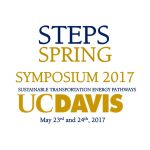
The STEPS team gathered 140 expert stakeholders and presented 2017 research results to date.
Agenda Packet – STEPS Symposium Spring 2017
Presentations
Day One – May 23, 2017
Alberto Ayala – Keynote_California’s Next Phase of Clean Car and Truck Policies for 2030
Session 1: Heavy-duty Trucks
Marshall Miller – Updates to Decision Choice Model and Summary of Fleet Workshop
Lew Fulton – Zero-Emission Long-Haul Trucking Technologies
Patric Ouellette – Liquid Biofuels for HD Trucks
Session 2: Electric Vehicles
Tom Turrentine – EV Market Update
Ken Kurani – A quasi-experiment in consumer choice of conventional and alternative fuel vehicles
Alan Jenn – A multi-model approach_international electric vehicle adoption
Session 3: Hydrogen
Zane McDonald – Hydrogen Storage for Curtailed Renewable Energy
Andy Burke – Hydrogen Fuel Cell Trucks
Day Two – May 24, 2017
Session 4: Biofuels
Rosa Dominguez-Faus – California Low Emission Truck and Policies and Plans
Julie Witcover – LCFS Status Review
Alissa Kendall – Life Cycle Assessment
Session 5: Mobility
Mollie d’Agostino – 3 Revolutions Policy Initiative Briefs
Miguel Jaller – Sustainable First and Last Mile Transport
Aria Berliner – Life Stage and its relationship with Shared mobility Use (and knowledge)
Lew Fulton – 3R Scenarios Results
Posters
1. Four California Rail Scenarios to 2050 – Raphael Isaac
2. The Role of Public Utilities in Transportation Electrification – Nicholas Bowden
3. Travel Time & Cost Savings of a 3 Revolutions Scenario – Dominique Meroux
4. The Cost of Electrifying Transport – Eamonn Mulholland
5. Modal Choice into TIMES – Jacopo Tattini
6. Mid-term Transition for Transportation Hydrogen Infrastructure – Guozhen Li
7. Truck Technology Choice Model Overview – Qian Wang
8. Truck Technology Choice Model More Samples, Indicative Results – Qian Wang
9. Exploring the US Air Fleet – in Use and in the Desert – Guozhen Li
10. Estimating the Impacts of First and Last MileTransit Access Programs
11. Change of Demand for Automobiles with Gasoline Price Changes – Qian Wang
13. Spatial regional consumer choice and fueling infrastructure model – Kalai Ramea
- STEPS Workshop: Critical Barriers and Opportunities for PEV Commercialization in California
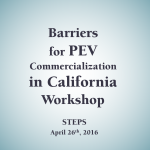
Infrastructure for Light-Duty Vehicles, Freight, and People Movement
April 26, 2016 at UC Davis
The California Energy Commission (CEC) and UC Davis Institute of Transportation Studies (ITS-Davis) will conduct joint workshops on April 25-26, 2016 with a goal to present and discuss insights on the status of PEV infrastructure in California, critical barriers, and recommendations to accelerate commercialization. The workshops are held at the CEC on April 25 and at UC Davis on April 26.
This April 26 workshop at UC Davis is hosted by the Sustainable Transportation Energy Pathways (STEPS) team, with funding generously provided by the CEC and US DOE. Funding for this research was generously provided by the CEC, through the National Center for Sustainable Transportation.
Thank you to all of our sponsors, presenters, and stakeholders engaged in these efforts.
Presentations
- Michael Nicholas (UC Davis) – PEV infrastructure, markets, and needs through 2025-2030
- Gil Tal (UC Davis) – Role of PEV infrastructure for PEV adoption
- David Greene (UT Knoxville) – PEV infrastructure: learnings from the literature
- Jake Ward (DOE) – EVSE costs
- Jamie Hall (GM) – Auto industry perspective on PEV infrastructure
- Colleen Quinn (Chargepoint) – Market Dynamics
- Dean Taylor (SoCal Edison)- Utility Perspective on PEV Infrastructure
- Leslie Baroody (CEC) – CEC on PEV infrastructure
- Phil Sheehy (ICF) – Readiness Planning and Implementation
- Sydney Vergis (ARB) – Sustainable Freight in California
- Handy, Susan L.

- Susan L. Handy
- Professor, Environmental Science and Policy
Interim Director, Urban Land Use and
Transportation Center (ULTRANS) - Associate Director for Education, Institute of
Transportation Studies - Director, National Center for Sustainable
Transportation - Chair, Transportation Technology and Policy
Graduate Group - Research Interests:
Relationships between transportation and land use; The impact of land use on travel behavior; Factors influencing bicycling as a mode of travel; Strategies for reducing automobile dependence
- Contact Info
- 2130 Wickson Hall
- (530) 752-5878
- slhandy@ucdavis.edu
- Technological, Economic and Environmental Potential of Natural Gas as a Sustainable Transportation Fuel in the US
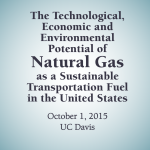
October 1, 2015 at UC Davis
Agenda and Attendees
Travel info – Directions, Parking, Lodging
Presentations
- Stephen Brown, RFF and University of Nevada, Las Vegas
- Patric Ouellette, Westport
- Emmanuel Varenne, Volvo
- Jeff Reed, SoCalGas
- Joan Ogden, UC Davis
- Nathan Parker, Arizona State University
- Chuck White, Waste Management
- Colin Carter, UC Davis
- Rich Kassel, Gladstein, Neandross & Associates
- Arvind Thiruvengadam, West Virginia University
- Fan Tong, Carnegie Mellon University
- Technologies and key challenges for bioenergy production in California
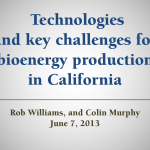
Bioenergy has the potential to significantly contribute to California’s climate-change, energy, and economic goals by producing low-carbon electricity and transportation fuels. Furthermore our state has the high-tech business capacity to be a leader in this field, as well as abundant resources from our agricultural and forest lands and municipal solid waste. The UC Davis Policy Institute for Energy, Environment, and the Economy in partnership with the California Biomass Collaborative presents a series of webinars to explore how California businesses, scientists, and policy-makers can sustainably unlock the State’s bioenergy potential.
Click here to view the presentation.
The second webinar took place on June 7th, 2013 . This webinar covered basic questions about the technologies available to produce energy from biomass and key challenges for expanding bioenergy production in California:
- How is biomass transformed into energy, fuel, and products?
- What state policies affect bioenergy in California?
- What does the future hold for bioenergy?
Speakers:
- Rob Williams, Development Engineer – California Biomass Collaborative, Department of Biological and Agricultural Engineering at UC Davis
- Colin Murphy, PhD Candidate, Institute of Transportation Studies
- The CCPM3 Workshop Report and Recommendations for the State of California is available
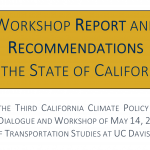
Find the report here
- The Feasibility of Renewable Natural Gas as a Large-Scale, Low Carbon Substitute
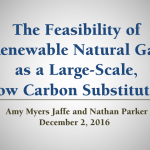
California will need high volumes of alternative low carbon fuels to be able to meet its climate change goals. In order to support these goals, this study investigated the technological and commercial feasibility of producing large quantities of renewable natural gas fuels for use in California. The study’s results indicate that there are substantial sources of RNG in California that are commercially competitive with existing fossil fuel-based transportation fuels because carbon externalities are taken into consideration in the California market through existing programs such as the Low Carbon Fuel Standard (LCFS) and the U.S. Renewable Fuels Standard (RFS). At current credit prices including California’s LCFS and the U.S. federal Renewable Identification Number (RIN) credits, up to 82 billion cubic feet per year (bcf/y) of RNG supply could be attractive for private investment at competitive rate of return in developing RNG sources from landfill, dairy, municipal solid waste and waste-water sites combined. We find that the LCFS credit of $120 per metric tonne of CO2, if taken alone, enables economically viable production of up to 14 bcf RNG transportation fuel over the study period, which begins in 2013 and extends into the 2020s, 6.3 bcf from landfill, 1.5 bcf from waste-water treatment, 1.75 bcf from municipal solid waste, and 4.3 bcf from dairy. If current carbon credit prices persist into the future for programs like the LCFS, a substantial portion of natural gas consumption in the transportation sector can be satisfied by RNG. The analysis also shows that increasing tipping fees for municipal solid waste can influence private investment in RNG. Finally, the study investigates the impact of California’s quality standards for RNG and distance to central distribution systems on the level of investment in certain kinds of RNG. These results support the implementation of the Low Carbon Fuel Standard, Short-lived Climate Pollutant Strategy, and incentive programs by providing insight into feasible methods to maximize the production of RNG via the most cost-effective pathways, thereby providing practical means to meet the State’s long term climate goals.
- The Hydrogen Transition
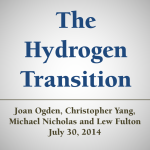
The early 2000s witnessed a surge in public interest in hydrogen fuel cell vehicles (FCVs), but the enthusiasm waned quickly. The public perception was that hydrogen was too difficult, and would not appear for several decades. However, in the past few years, important factors have emerged that are re-accelerating the commercialization of hydrogen and fuel cell technologies.
This webinar is the first public presentation of the recently published white paper: “The Hydrogen Transition.” The lead researchers, Joan Ogden, Christopher Yang, Michael Nicholas and Lew Fulton will present an analysis of the issues surrounding a transition to large-scale use of hydrogen, examining the current status of hydrogen vehicle and infrastructure technologies, and ongoing early commercialization efforts.
To download the PowerPoint presentation, please click here.
- Three revolutions are underway in urban transportation around the world: vehicle electrification, automation, and shared (on-demand) mobility. We do not yet know the manner in which each of these will unfold or how they may interact; the way in which these changes take place will have major implications for cities over the coming decades.
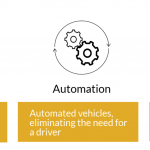
- Three Routes Forward for Biofuels
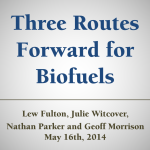
To view the slides for the May 16th webinar, click here.
Biofuels present great promise but also great challenges. For the past 10 years the enthusiasm around cellulosic biofuels has waxed and waned. At the same time, a great deal of innovation has occurred at existing ethanol and biodiesel plants. This webinar is the first public presentation of the recently published white paper: “Three Routes Forward for Biofuels: Incremental, Transitional, and Leapfrog”. The lead researchers, Lew Fulton, Geoff Morrison, Nathan Parker, and Julie Witcover, will discuss potential routes for biofuel industry development while considering investments made to date, related policies, technology GHG profiles, and barriers to commercialization.
There is also a post on the GreenLight Blog discussing the white paper.
- Turrentine, Tom
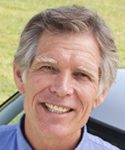
- Tom Turrentine
- Director, Plug-in Hybrid & Electric Vehicle Research Center
Research Anthropologist - Research Interests: The role of travel and movement in the evolution of culture, society and lifestyle
- Contact Info
- 1590 Tilia Street (West Village), Office 1105
- (530) 752-1768
- tturrentine@ucdavis.edu
- Truck Choice Modeling: Understanding California’s Transition to Zero-Emission Vehicle Trucks Taking into Account Truck Technologies, Costs, and Fleet Decision Behavior
Truck Choice Modeling: Understanding California’s Transition to Zero-Emission Vehicle Trucks Taking into Account Truck Technologies, Costs, and Fleet Decision Behavior
- Truck Choice Workshop
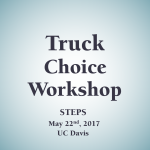
This workshop focused on outreach by our STEPS Truck Choice project team to a group of OEMs and fleets, to better understand how fleets decide what types of trucks to purchase, in particular with respect to various propulsion technologies and fuels for given truck categories and purposes.
Agenda Packet – Truck Choice Workshop
Summary of Fleet Workshop (presented at the STEPS Symposium on May 23) – Marshall Miller
Presentations
Tony Brasil, ARB – California Low Emission Truck and Policies and Plans
Session 1: STEPS Team provides background, preliminary findings and workshop goals
STEPS Truck Choice Project – Marshall Miller, Lew Fulton, Joan Ogden, Qian Wang, Chris Yang
Session 2: Fleets Purchasing Decisions (Heavy-duty)
Scott Perry – Ryder System, Inc. Overview
Ken Gillies – Element Fleet Management
Session 3: Fleets Purchasing Decisions (Vocational/delivery/other)
(no slides)
Session 4: OEM Perspective, Technology and Vehicle Development
AJ Naddell – BYD Electric Trucks
Session 5: Experts Discuss Policy
(no slides)
Session 6: Feedback from Participants
(no slides)
- Lew Fulton chairs session at UC Davis side event at GCAS
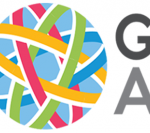
visit page here
- UC Davis Transportation Researchers Collaborate with State Policymakers on CA Sustainable Freight Plan

By: Miguel Jaller and Lew Fulton
When the state earlier this month released for public comment its draft California Sustainable Freight Action Plan (CSFAP), we were excited to see the fruits of our labors here at ITS-Davis contributing to this comprehensive and forward-thinking draft plan.
CSFAP is an ambitious document that lays a foundation for modernizing California’s multi-billion dollar freight transportation system. Seven state agencies worked together to develop the draft in response to Governor Brown´s Executive Order B-32-15 last July, which directed the state agencies to pursue a shared vision to “improve freight efficiency, transition to zero-emission technologies and increase the competitiveness of California’s freight system.” The public comment period on the draft CSFAP is open until July 6.
Our role in the development of this plan has been to advise and convene, and to provide technical analysis and input. Just after the release of the governor’s executive order, ITS-Davis and the National Center for Sustainable Transportation convened stakeholders from academia, industry and government to discuss and identify strategies to inform the CSFAP. This working group of experts, the Freight Efficiency Strategies Development Group, met over the last eight months and produced a set of six white papers that are included in the CSFAP materials. Rather than make specific recommendations, the white papers discuss a range of strategies that could be used, granted further analyses, to accomplish some of the state’s goals for efficiency, safety, economic competitiveness, environmental and social justice, and introduction of new technologies.
Our UC Davis team led the development of two of the white papers, “Strategies to Maximize Asset Utilization in the California Freight System Part 1 and Part 2.” We highlight the importance of looking at the freight system as a whole and complex system of systems, where strategies aimed at specific stakeholders could have cascading, positive or negative, effects over others. Therefore, designing policies or strategies that consider behavioral shifts and efficiency improvements requires identifying the appropriate decision makers, which could range from large private organizations, planning agencies, or even industry sectors to households and individuals requesting residential deliveries. More importantly, the papers recognize that continuous improvements and investments are being made in the system, though in a silo manner, which do not guarantee reaching system-level efficiency improvements. That is, some efficiency gains by specific stakeholders could be done at the expense of the inefficiency of others.
To reinforce the state’s efforts, last October we launched our own Sustainable Freight Initiative here at ITS-Davis. It has two main interdependent thrusts: sustainable freight systems, and technology and fuel analysis. Our critical research dovetails nicely with the findings of CSFAP. For example, we are studying:
- The relationship between freight activity and economic and social indicators;
- The impacts of the on-demand economy and associated “last mile” distribution on urban traffic and environmental conditions;
- Freight demand management strategies to improve urban goods movement;
- The development of equity-based frameworks to assess the benefits of transportation infrastructure projects;
- Pathways to very low carbon trucking, considering logistics and new technologies and fuels, such as biogas and other biofuels, electricity and hydrogen, and their potential for application to various truck applications and market segments
- Strategic, tactical, and operational problems for urban goods distribution, with an emphasis on commercial and residential deliveries;
- Opportunities and options for reducing CO2 emissions from the California rail freight sector.
Moreover, for the first time, we’ve offered an academic course on sustainable freight transportation; we hope it’s the first of many on this important topic.
In the coming years, we expect to contribute more research and knowledge, and support workforce development and stakeholder engagement to achieve the state’s targets of system efficiency, a transition to zero emission technology, and economic growth. Since we are a key contributor to the Freight Efficiency Strategies Development Working Group and are already part of the draft plan, we will continue working with the agencies to identify and refine the scope of additional strategies, and help with deployment activities.
The CSFAP has been called “innovative” and potentially “transformative.” But it’s clear that a combination of strong improvements in freight systems as well as technology and fuel solutions will be required to meet the state’s emissions and sustainable freight goals. ITS-Davis looks forward to being part of the effort to identify and develop the most promising solutions.
- UN Climate Change Conference COP22 in Marrakech: Launching a New Era of Transportation Practicalities
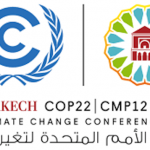
I spent only two days in Marrakech for the 22nd annual United Nations Climate Change Conference – “COP22.” But it was enough to see that a) the commitment of countries and participants is still very high despite the results of the U.S. election, and b) the excitement of the Paris Agreement last year has given way to work “in the trenches” – the slow process of developing national CO2 targets and strategies to meet those targets, as per the commitments made under the agreement.
Thus a key theme of COP22 was debating how best to create a fair “rulebook” that all countries could share and have confidence in when assessing each other’s climate pledges. The technicalities of the rulebook—baselines, methodologies, etc.—will likely be a continuing discussion into 2018. This timeline means that few of the loose ends left by the Paris Agreement were completely tied up in Marrakech. But it was clear in the transportation meetings I attended that countries are now finally grappling with details:
• How do their overall “Nationally Determined Contribution” (NDC) targets compare to other countries’?
• How can they achieve these targets?
• Where does transportation fit in this big picture?
• What policies should they consider adopting for transportation and what types of impacts will specific policies have?In fact, as detailed in a very useful 2016 report by the Partnership on Sustainable Low-carbon Transport (SLoCaT), while 75% of the 138 existing NDCs developed before the COP specifically mention transport as an important sector for reductions, only 63% include any specific transportation mitigation measures, and only 9% have developed a transportation-specific target for CO2 reductions. A major point of discussion on November 13th the “Transport Day” workshop in Marrakech was this: What levels and types of targets should countries be considering for their transportation sectors?
In considering this, the following figure is instructive. Based in part on International Energy Agency (IEA) scenarios and in part on countries’ own plans to date, it shows the stark difference between a “business-as-usual” (BAU) scenario and “low-carbon scenarios” for transportation worldwide. The low-carbon scenario is based on reviewing a wide range of studies on what appears feasible given a fairly strong mix of measures; this is roughly aligned with a transportation trajectory consistent with the IEA 2 degree scenario, where 2050 emissions are about 20% below 2010 levels.
However there was much discussion at this COP about achieving a 1.5-degree target, given the strong call for this in the Paris Agreement. This is (perhaps surprisingly) estimated to be much more challenging than achieving 2 degrees since a) the full economy-wide carbon budget must be much lower and- related CO2 emissions should actually hit net zero before 2050, and b) since transport does not decarbonize that deeply under a 2 –degree target it is left with a large additional “workload” under a 1.5-degree target, to achieve near zero emissions by 2050. (It does not quite reach zero on the assumption that other sectors, notably electricity generation, manage to go below zero such as through a combination of bioenergy and carbon capture and storage strategies.)

Source: SLoCaT, 2016To achieve such a 1.5 degree target, countries will literally have to “throw the kitchen sink” at the problem, with strong national and sub-national commitments in all aspects of transportation including “avoid”, “shift” and “improve” options. Very strong land use planning efforts, major investments in public transit systems, walking and cycling infrastructure, strong pricing mechanisms, and a major push toward greener vehicles (via fuel economy improvements and a transition to very low-carbon energy systems) were all discussed as needing to be part of the answer. Previous debates about “technology vs. behavior” have given way to “we have to do it all” discussions. For urban transportation, the idea of a 50-50 strategy between “avoid/shift” and “improve” strategies seemed to take hold. Air and shipping were also discussed and there was a consensus that these modes may be even more difficult to decarbonize than land transportation, given the limited options and lack of electrification potential.
Meanwhile, a separate meeting of transportation modelers, ITEM-2 (the “International Transportation Energy Modeling” group, founded by Sonia Yeh and myself) was held two weeks prior to the COP in Chalmers, Sweden. This meeting included 12 major models and modeling groups, and undertook a range of comparisons of BAU and low-carbon scenarios. Basically none of the models has developed a transportation pathway approaching the 1.5-degree scenario in the above figure, and even 2-degree transportation scenarios are clearly a challenge for these models. A compilation of scenarios from the meeting is shown the figure below.
Selected ITEM-2 BAU/transitional (black) and low-carbon (green) scenarios

Source: ITEM conference, Chalmers Sweden, 25-26 October, 2016But at that meeting there was an agreement to continue to develop stronger, more ambitious scenarios, and this was reiterated when the results of this workshop were presented during Transport Day at the COP. It was generally agreed that this modeling group, that includes universities such as UC Davis, international organizations such as IEA, ITF and IIASA, and energy companies such as Shell and BP, can serve as an important “sounding board” for the COP system and individual countries going forward as they develop their own strategies and attempt to estimate the potential CO2 reductions that they can achieve.
In the end, this COP, at least for transportation, has launched a new era of practicalities – developing detailed plans and strategies, along with quantitative assessment tools to score these as well as track progress.
The STEPS program at ITS-Davis will stay closely involved as this process moves forward, offering to provide important analysis that can help underpin the global approach underway to decarbonizing transportation.
Lew Fulton is the co-director of the Sustainable Transportation Energy Pathways (STEPS) program at the UC Davis Institute of Transportation Studies.
- Vehicle Technology Evaluation
This research centers on developing models of the driveline components and simulation of advanced vehicle operation on appropriate driving cycles. Research also assesses the effects of fuel requirements and availability on advanced vehicle development across the different fueling methods studied in the STEPS Program. Mathematical modeling tools allow researchers to make cross comparisons between conventional and alternative fueled vehicles in order to assess performance, fuel economy, and emissions production.
Research Leaders: Andy Burke Hengbing Zhao
- Equity Impacts of Fee Systems to Support Zero-Emission Vehicle Sales in California
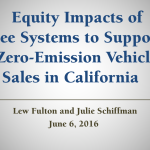
Speakers
Lew Fulton – STEPS Program Co-director, Institute of Transportation Studies, University of California, Davis
Gil Tal – Researcher, Plug-In Hybrid & Electric Vehicle Research Center, Institute of Transportation Studies, University of California, Davis
Julie Schiffman – Graduate Student, Institute of Transportation Studies, University of California, DavisEvent Overview
California has set ambitious goals for increasing the number of zero-emission vehicles (ZEVs) on its roadways. Currently, California requires 3% of all vehicles sold in the state to be ZEVs and transitional ZEVs; and has set aside $75 million to provide rebates to consumers, which range from $900 to $5,000 per vehicle. Subsidies and incentives may be needed for zero-emission vehicles for a decade or more. What are options for a revenue neutral, self-sustaining vehicle tax incentives system? How would a system be structured so that it is acceptable to key stakeholders, fair across demographic/income groups and economically efficient? This webinar will highlight new analysis from the Institute of Transportation Studies, UC Davis, that examines six hypothetical fee structure scenarios that could provide a sustainable source of funding for California’s Clean Vehicle Rebate Program. The scenarios explore different options for setting vehicle fees based on CO2 emissions of individual non-ZEV vehicle models, adjustments to the amount paid by lower income groups, and adjustment of fees by Manufacturer’s Suggested Retail Price.
Recording
- Why the World’s Appetite for Oil Will Peak Soon
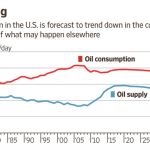
By Amy Myers Jaffe
When it comes to oil demand, the conventional wisdom is clear: Population growth and a rising global middle class guarantee that demand—and prices—will rise over the coming decades. It is a story line that is almost universally accepted by investors, governments and industry alike.
But like many such consensus views, it is one that should be treated with caution.
The world’s economy is experiencing transformational changes that, I believe, will dramatically alter patterns of energy use over the next 20 years. Exponential gains in industrial productivity, software-assisted logistics, rapid urbanization, increased political turmoil in key regions of the developing world, and large bets on renewable energy are among the many factors that will combine to slow the previous breakneck growth for oil.
The result, in my opinion, is as startling as it is world-changing: Global oil demand will peak within the next two decades.
The geopolitical and economic implications of peaking demand will be huge. The fall in the importance of Saudi Arabia is already palpable, with all the major powers from the U.S. to China more willing to accommodate Saudi archrival Iran. In addition, Russia’s ability to use oil as a weapon will wane, as will the economic leverage of the Organization of the Petroleum Exporting Countries. As economic growth becomes increasingly disconnected from oil, world powers will likely shift their attention to other increasingly scarce resources that will be equally critical to economic well-being, such as food, water and minerals. A greater interest in Africa, for example, is already starting to emerge.
For sure, peak demand is far from how the oil patch sees things. The oil industry’s operating premise is that a rising global middle class from China, India, Indonesia, Malaysia, Thailand and parts of Africa and the Middle East will translate into soaring car ownership and fuel consumption. Officially, the International Energy Agency forecasts oil demand rising to 104 million barrels a day by 2040 from 90 million barrels a day in 2013, as surging demand in the developing world dwarfs the demand declines expected in the industrialized countries.
But I believe this forecast misses on both fronts—underestimating the extent of the decline in demand for oil in the developed world and overestimating the extent of the rise in the developing countries.
Signs of change are already apparent. Most everyone agrees, for instance, that a combination of policy inducements, energy taxes and technological breakthroughs has resulted in a peak in oil demand in the largest industrialized economies. Europe’s oil use last year hit its lowest level since the mid-1990s. The U.S. Energy Information Administration declared 2007 as the peak year for oil use in the U.S., with demand expected to fall by between 1.8 million and 2.7 million barrels a day by 2035 based on improvements in automotive efficiency and demographic trends.
Moreover, signs are emerging of slowing oil demand even in China, which has been the biggest source of growth in consumption over the past decade. Diesel demand in China fell in each of the past two years, raising doubts about how much longer China’s economy will require a growing supply of oil. China Petroleum & Chemical Corp., one of China’s largest fuel marketers, recently said on a call with analysts that China’s diesel demand could peak by 2017 and gasoline by 2025 as the country transitions to less-energy-intensive activities and sees through an aggressive national energy policy that promotes renewable energy and advanced automotive technology at home and for export.
IT efficiencies
But these trends are just the beginning of what will be a gradual shift that will eventually get the whole world to a peaking of oil demand.
Let’s start with the most important: the advent of information technology and big data, which are bringing revolutionary changes to daily life, especially for millennials. Exponential gains in productivity are expected for everything from transportation logistics to industrial equipment, which together with the growth of the sharing economy offer potentially dramatic savings on energy use.
We all know how much we optimize routing, timing, loading and sharing through the use of our own mobile devices. Mobile apps that help drivers avoid traffic congestion save fuel, for example, since idling in traffic wastes about 2.9 billion gallons of fuel a year in the U.S.
What might be less obvious is how this combination of satellite imagery, remote sensors, communications technology, cloud-based computing, robotics and “smart” industrial machinery is reducing the amount of fuel needed in other kinds of economic activity. Big-data analytics applied to aviation navigation is already shaving 10% to 20% off fuel demand, and similar advances are expected in the rail industry. Manufacturing via automation and 3-D printing are also expected to reduce fuel requirements.
Business-as-usual oil forecasts are also predicated on a rising need for consumer plastics, but this, too, may prove wildly overstated. Roughly 5% of global oil consumption goes to plastics production.
While it is hard to eliminate plastics from daily life, consumer companies have been trying to reduce their plastics footprint, in part in response to millennial consumers who are pushing companies to reduce waste, lower carbon emissions and eliminate landfills through intelligent design, smarter materials and recycling. Global retailers, such as apparel companies, are moving away from plastic packaging, and car companies are considering similar strategies that would curb demand for plastics substantially.
Fewer car commuters
Rapid urbanization may also point to a future drop in oil demand. Cities currently account for about 66% of global energy use, with forecasters projecting that figure to rise to 80% as the population shifts to urban centers.
But this trend of massive urbanization will more likely reduce the viability of private car ownership in the very places that are supposed to serve as the new centers of oil use, such as India, Indonesia and the Arab Gulf. Chances are, air-pollution concerns and congestion in mega-cities will prevent giant increases in the number of cars, and therefore hinder the substantial rise in oil demand that forecasters are expecting.
Increasingly, cities around the world are seeking smarter designs for transport systems as well as penalties and restrictions on car ownership. Already in the West, trendsetting millennials are urbanizing, eliminating the need for commuting and interest in individual car ownership, just as their baby-boomer parents are retiring and driving less.
At the same time, increased turmoil and low oil prices are crippling economic activity in parts of the Middle East and Africa, the two regions that are supposed to be the big drivers of continued growth in oil use. The wealth-accumulation prospects for the middle classes in these societies are uncertain—and so, therefore, is their demand for oil. What’s more, many state-sponsored fuel-price subsidies, which have been a key driver of oil demand in the developing world, are rapidly disappearing.
Finally, renewable energy is turning out to be more promising than expected, eating away at oil’s share of electricity production—and, eventually, automotive energy. China’s commitment to an industrialization program pushing itself to be the world’s major exporter of solar panels and advanced vehicles, including the production of five million electric vehicles a year, is another source of caution to those who forecast oil demand will rise exponentially forever.
None of this is set in stone, of course. A lot could change in the coming years—economically, politically, technologically—that could alter the oil-demand equation. But as Paris climate talks approach, governments around the world will be working to highlight their energy-efficiency policies and sharing information on how to lower oil intensity for the global economy. Whatever collective gains they make could seal the deal for peak demand.
- Workshop: Beyond Light Duty Vehicle Electrification of Goods and People Movement
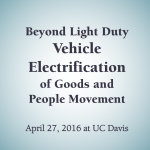
April 27, 2016 at UC Davis
The UC Davis Institute of Transportation Studies (ITS-Davis) helped to host a workshop on April 27, 2016 to identify high-potential beyond-LDV electrification market opportunities and the vehicle technologies to match them and align stakeholder needs with the qualitative and quantitative analysis planning and early work already underway through the Department of Energy’s EV Everywhere Program.
Thank you to all of our sponsors, presenters, and stakeholders engaged in these efforts.
Presentations
- Jake Ward presentation on DOE Transporation as a System
- Alicia Birky EV Everywhere Goods and People Movement presentation from Energetics
- Ben DeAlba presentation from CALSTA
- Dan Bowermaster presentation from EPRI
- Mark Greer presentation from Altec
- John Petras presentation from Odyne
- Adam Duran presnetation from NREL
- Johanna Pirinen presentation from Konecranes
- Mike Simon presentation from Transpower
- Marcus Alexander from EPRI
- Jim Castelaz presentation from Motiv Power Systems
- Doyle Sumerall presentation from NTEA
- Amy Dobrikova presentation from Intelligent Fleet
- Ed Lovelace presentation from XL Hybrids
- David Owen presentation from CenterPoint Energy
- Fan, Yueyen

- Yueyue Fan
- Associate Professor, Civil and Environmental
Engineering - Graduate Adviser, Transportation Technology and
Policy Graduate Group - Research Interests:
Transportation and renewable energy infrastructure system modeling and optimization; Critical transportation and energy system protection; Adaptive network routing and research allocation processes; Stochastic and dynamic system modeling and computational methods
- Contact Info
- (530) 754-6408
- Ghausi Hall
- yyfan@ucdavis.edu

